Marketing | How To

How to Create a Small Business Marketing Plan (+ Free Template)
Published February 19, 2024
Published Feb 19, 2024
WRITTEN BY: Michael DeVault
- 1 What’s in a Small Business Marketing Plan
- 2 How to Create a Marketing Plan in 6 Steps
- 3 Why You Should Invest in Marketing Your Small Business
- 5 Bottom Line
Whenever I’m tasked with launching a new small business or helping an existing business increase sales, I sit down with the owner to develop a small business marketing plan. You might be surprised how many small businesses overlook the importance of creating a marketing plan, opting instead to thrust blindly into one advertising medium or another.
Taking a few moments to familiarize yourself with the components of a small business marketing plan will help you navigate the process. It’ll also set you up to maximize your brand presence .
What’s in a Small Business Marketing Plan (+ Free Marketing Plan Template)
When assembling a plan for marketing and advertising your small business, you’ll be pulling together several diverse components from across your small business and the industry in which you’re operating. The parts of your plan may vary slightly, but overall they should include:
- Customer personas: If you can’t identify your core customers, how do you plan to talk to them? Customer personas help you accomplish this.
- Marketing and advertising goals: Without setting goals, how do you know what’s working? Setting trackable and achievable goals will guide your planning.
- Unique value proposition: What sets your business apart from the competition? This is your unique value proposition, which is what drives customers to buy your product.
- Types of marketing: Where will you market and advertise your products or services? Whether it’s on a small business website or in the local newspaper, you should consider all your options.
- Marketing budget: How much can you afford to spend on marketing and advertising your company? Setting a realistic budget and sticking to it is key to a successful campaign.
FILE TO DOWNLOAD OR INTEGRATE
Marketing Plan Template
Thank you for downloading!
To get expert advice and guidance with your marketing plan, get a free consultation from Straight North. Branding and marketing experts will outline effective strategies to build and grow your business without the hassle of running your own marketing plan.
How to Create a Marketing Plan for a Small Business in 6 Steps
Creating a plan to launch and manage your marketing campaign is straightforward. You can create an effective plan in just six steps. See the steps below to learn more about what you’ll need to do.
Step 1: Identify Your Target Customers
You can’t do a good job talking about your product or service without knowing who you’re talking to. And you certainly don’t want to waste time and money talking to people who aren’t potential customers for what you’re selling. Think about it: If you own a landscaping company, you don’t want to advertise to people living in a condo, right? That’s where identifying your customers comes into play.
The first thing you’ll do is make a list of attributes you think your core customers share. These attributes include age, demographic information, geographic location, and general interests. You can even divvy up customers by age bracket—known as generational marketing . Here are a few key details you should identify about your customers:
- Service area: Where do your customers live and work? Without knowing this, you won’t be able to adequately target ads to them.
- Demographics: Are your customers predominately one gender? Maybe they fit into an age bracket. Understanding the demographics of your customers allows you to tailor a message to them.
- Economic factors: Will customers be able to afford your products or services? You’ll need to consider the income level of potential customers and weigh that against how many people meet those criteria.
This is a good start. But gathering information about potential customers is just a start. You can go a step further with customer personas. A customer persona is a fictional “perfect customer” you create from the information you’ve gathered. The goal is to have a specific individual you’re crafting each marketing message for. Creating a customer persona is easy, especially once you’ve identified some key details about your customer.
Step 2: Set the Right Goals for Your Campaign
It may seem like a given—the notion that you should set goals for your campaign. However, many businesses fail to set proper goals in their marketing plan and, as a result, fail miserably. So what makes the “right” kind of goal? Goals for your campaign should meet four criteria:
- Be achievable: Your goals should be reasonably achievable with the marketing tools and resources available to your business.
- Be specific: Each goal you set should have a specific target attached to it. It’s not good enough to say the goal is to “increase sales.” Instead, specify your program will “increase sales by 20%.”
- Be quantifiable: Even if you set a specific target, you need to be able to measure it. Your goals should be based on things you measure, such as per-ticket sales or new customer counts.
- Be justifiable: You might set a goal to double your sales, but if doubling your sales costs more in marketing budget than profits generated, you’ve missed the mark. The finish line should justify the effort.
Step 3: Differentiate Yourself From the Competition
With millions of small businesses operating in thousands of industries, it’s a crowded marketplace. How you stand out will greatly affect how your marketing impacts people who may be looking for what you are selling. Ask yourself this question: What makes my product different and better than my competitors?
The answer to this question is your unique value proposition (UVP). Also known as a unique selling position (USP), this differentiating factor drives customers away from your competitors and to you. For example, for a catering company, a unique selling proposition might be “the best vegan food in town.”
The point of a unique value proposition is to set yourself apart from literally everyone else. This question could well be the most important question to ask yourself before opening a small business. Every business should have a unique selling position. After all, if you’re not bringing something unique to the table, why would customers choose you? Ultimately, your unique selling proposition will drive a large part of a startup marketing strategy .
Researching Your Competitors
It probably goes without saying, but in order to differentiate yourself from your competition, you’ll need to learn a little bit about the companies you’ll be competing with. That means spending time on their websites, social media profiles, and the web to understand their positions in the market, how they’re reaching customers, and their value propositions.
Competitor research provides you with insights on pricing and buyers as well as details you can use to create customer personas or help plan your advertising campaign.
Step 4: Choose the Types of Marketing You’ll Do
Armed with your customer personas, a list of achievable goals, and a unique selling position, you’re now ready to pick the kinds of marketing you’ll want to do. Since the ultimate goal is to reach as many potential buyers as possible, you’ll want to focus your efforts where you can reach the most of them.
Generally speaking, there are four types of marketing to consider. Each type of marketing requires different resources and impacts customers in unique ways. Here is a broad overview of each of the four areas:
Internal Marketing
You’ve already done some thinking about internal marketing. Internal marketing includes that unique value proposition, which is part of your brand identity . Additional components of internal marketing include:
- Mission statement
- Vision statement
- Core values statement
Internal marketing shapes everything you’ll say in the rest of your marketing efforts. Start with your internal marketing positions and you’ll have a strong message to share with customers.
Online Marketing
Online marketing includes literally every activity your business undertakes online. Over the years, online marketing has become an increasingly important part of a small business digital marketing plan. This includes:
- A well-designed website
- Search engine optimization (SEO)
- Online advertising through Google, Bing, and more
- Social media marketing on Facebook, Instagram, X (formerly Twitter), and more
- Email marketing
- Press releases
- Online reviews and ratings
Each of these types of marketing requires attention and planning of its own. Consider how you’ll establish a website for your small business. Will you pay someone to create a website for you? Or will you do as many small business owners do and choose to do it yourself with the help of a drag-and-drop website builder ?
Online marketing through social media, SEO, email, and a small business website requires specialized tools. These tools include data tracking and analytics, design, and more. They make up part of your marketing technology—or MarTech—stack. Learn more about how to build a MarTech stack with our how-to guide.
Offline Marketing
Not all marketing happens on the interwebs. Depending on the type of business you own and the market you’re in, you’ll probably need to invest in some offline marketing as well. Offline marketing includes those “traditional” types of advertising like newspaper and print ads, as well as some of the newer practices, like vehicle wraps.
While it’s true offline marketing plays a lesser role than it has in the past, it’s nevertheless important to consider what resources you want to devote to this medium. Billboards and direct mail continue to be remarkably effective and affordable ways to reach clients who aren’t at a computer, with the cost-per-impression (CPI) of billboards ranging from $2 to $9.
Offline marketing also includes materials and activities you might not think of as marketing. Business cards, flyers, and brochures are just some of the kinds of marketing materials at your disposal.
Broadcast Marketing
Broadcast marketing is the most familiar form of advertising and marketing. It’s also among the most expensive. Broadcast media includes television, radio, and most recently, podcasting and streaming.
For some small businesses, broadcast will play a role in getting your message out. However, many small businesses find tremendous success without ever investing a dime in broadcast advertising. Only you can determine what forms of advertising are right for your business.
Step 5: Craft a Marketing Budget & Calendar
Now that you’ve got a handle on what you want to say, who you want to say it to, and where, you’re ready to book your ads. Unless your budget is unlimited, it’s not as simple as just picking up the phone and placing orders. You need to decide how much money you can spend and where you can get the most bang for your buck.
That’s where a marketing calendar comes in. Working with local ad representatives, you can determine how much offline advertising will cost you. You can also get a reasonable idea of how much you’ll spend on pay-per-click (PPC) ads on Google and Facebook. To help maximize your budget, spread out your ad spend over the course of each month with a media calendar.
Below is a link to our local marketing media calendar template. You can use this template to map out your advertising efforts.
Marketing Calendar Template
Step 6: Track Progress & Update Your Campaigns
With your advertising and marketing efforts now up and running, you’ll want to keep tabs on three core metrics: how much you’re spending, how many people are seeing your ads, and how much your sales are increasing. Measuring each of these relies on different tools, and in many cases, you’ll have to rely on specific tools for individual types of advertising.
For example, if you’re measuring the reach of your Google Ads placements, you’ll spend time in the Google Ads control panel, tracking how many clicks each ad receives—as well as how much each click is costing you. For broadcast advertising, your ad reps will provide you with the estimated number of impressions each ad gets.
Fine-tuning Your Advertising & Marketing
The most important metric to track will be your revenues. You’re advertising to gain business, right? It only makes sense to track how much business you’re receiving. While you can take a top-line view and assume your ads are driving increased revenues, you can and should try to determine which ads are producing the best results and which ones are falling short.
Online advertising makes this easy because you’ll receive reports from Google and Facebook about how many clicks they’ve sent your website. Your website is also a powerful tool to track where customers are coming from. Email marketing is another easily trackable advertising form, as email marketing platforms provide ample data to quantify how well your message is landing.
For offline marketing, it can be more challenging to measure the effectiveness of a campaign. However, it’s not impossible. Offering pricing specials or coupons can help you measure where customers are hearing about you. Also, many broadcast outlets provide tools to help track the success of your program.
Why You Should Invest in Marketing Your Small Business
Now that you’ve developed a marketing plan, you’re ready to get started growing your business. However, you may still be wondering why you should invest the time and money into marketing efforts that may or may not work. The answer is simple: Marketing is the only way customers have to find out about your business and what you’re offering.
Put another way, everything you do to spread the word to potential customers that you can fill their needs—from television ads to handing out business cards at a trade show—is all marketing. Plan well and your efforts will bear fruit.
Frequently Asked Questions (FAQs)
What is a marketing plan.
A marketing plan is a written strategy outlining target customers, sales and revenue goals, the kinds of marketing you’ll use, and when you’ll run the ads based on that plan. Marketing plans control everything from billboards to Facebook ads. With an effective marketing plan, you can control expenses, grow your customer base, and drive sales.
How do you create a marketing plan?
To create a marketing plan, you must identify your target audience, set goals for your marketing campaign, and differentiate yourself from your competition. Then, you’ll choose the kinds of marketing and advertising you want to use, such as running ads on television or launching a website. Set a budget you can afford—a good rule of thumb is 10% of gross revenues—and track the progress of your marketing efforts, updating your plan as you go.
Do I have to make a marketing plan for my small business?
While no one is forcing you to create a marketing plan, it’s still a good idea to make one. A marketing plan guides the message you create and provides a framework for sharing that message to potential customers. It also gives you the ability to control expenses, maximize return on investment (ROI), and modify marketing plans that aren’t working.
Bottom Line
Creating a marketing plan for your small business doesn’t have to be a challenge. In fact, it’s really quite simple. Identify your customers, craft your message, and decide where you should share that message. Once your marketing plan is up and running, remember to take some time to make sure it’s producing the results you want, and make adjustments to help maximize return on your investment.
About the Author

Find Michael On LinkedIn
Michael DeVault
Michael DeVault is a career journalist with more than 20 years in media and marketing. He has an extensive background in franchise marketing, having worked with some of the biggest names in franchising, including iconic names like SONIC, Captain D’s, and Fantastic Sam’s.
Join Fit Small Business
Sign up to receive more well-researched small business articles and topics in your inbox, personalized for you. Select the newsletters you’re interested in below.
- Credit cards
- View all credit cards
- Banking guide
- Loans guide
- Insurance guide
- Personal finance
- View all personal finance
- Small business
- Small business guide
- View all taxes
You’re our first priority. Every time.
We believe everyone should be able to make financial decisions with confidence. And while our site doesn’t feature every company or financial product available on the market, we’re proud that the guidance we offer, the information we provide and the tools we create are objective, independent, straightforward — and free.
So how do we make money? Our partners compensate us. This may influence which products we review and write about (and where those products appear on the site), but it in no way affects our recommendations or advice, which are grounded in thousands of hours of research. Our partners cannot pay us to guarantee favorable reviews of their products or services. Here is a list of our partners .
How to Write a Marketing Plan

Many or all of the products featured here are from our partners who compensate us. This influences which products we write about and where and how the product appears on a page. However, this does not influence our evaluations. Our opinions are our own. Here is a list of our partners and here's how we make money .
A marketing plan outlines your marketing strategy, which includes how you’ll attract new customers, retain current customers and promote your products or services. Creating a marketing strategy is key to ensuring you’re making the most of your money while targeting the right people through the right channels so you can grow your business.
When you create your business plan, the marketing plan will be an important component. Within a business plan, the marketing plan helps to explain how your business fits into the market, who your competitors are and how you’ll stand out. Small-business marketing is all about how you will promote your products or services to increase sales through customer engagement.
1. Research
The first step when learning how to write a marketing plan for your business plan is research. You want to look at your market as a whole , your competitors, their marketing strategies and past marketing strategies you’ve used — if any. Your research will inform who your target customer base is, how to price your products , what marketing channels will best serve your business, how you want to interact with customers and what your marketing budget will be.
While not all your research will be included in your marketing plan, it will help to inform your marketing strategy. The final product will be a much condensed and synthesized version of what you discover from your research.
2. Know your business
To create an effective marketing strategy, you need to understand the ins and outs of your own business. What makes your products or services unique? What’s your company’s mission? Why did you start this business in the first place? Reminding yourself what makes your business special will help you inform your marketing strategy and show potential customers why they should choose to work with you. Plus, looking at your business from the viewpoint of a potential customer may help you uncover some unique selling points you hadn’t previously considered.
» MORE: Can your small-business idea actually make money?
3. Understand your customer
Beyond your business and the products or services it offers, you also need to take your customer into consideration when writing your marketing plan.
Understand your customer: who they are, what they like, their pain points, how your product or service solves their problem, how and where they consume media and how to communicate with them. Much of the success of your marketing strategy depends upon knowing and communicating well with your customers.
Identify your target market and narrow your scope to a specific demographic — like athletes or parents, for instance — to help you pinpoint the best way to reach them. If you cast your net too wide, you may come off as insincere and struggle to attract any customers.
4. Highlight your unique selling proposition
Your business’s unique selling proposition, or USP, is the thing that makes you stand out. If you want your product or service to sell well, you need to make sure it offers something your competitors don’t. To do that, you need to find your USP.
You likely have a good idea already of what your USP is, but it’s time to synthesize all of the great ideas you gathered in the previous steps into an easily shareable description. Consider this your elevator pitch. You want to be able to tell someone why your product or service is best in less than 30 seconds. You may also find a catchy slogan comes out of this, as well.
5. Check out the competition
While you need to make decisions that are right for your business based on internal information, you also should have an understanding of what your competitors are doing and how it’s working for them.
Take a look at their products, pricing and marketing strategies. Check out their customer reviews to see what people like and dislike about their business. Then use this information to make your business — and marketing strategy — even better.
6. Know your numbers
A marketing strategy will cost money; however, it doesn’t have to be a lot. In fact, there are plenty of free marketing ideas you can try. However, you will likely need to spend some money if you want to make money in the long run. Understanding your business financials to come up with a realistic marketing budget is crucial before you can decide on your concrete marketing plan.
7. Show, don't tell
If you have any marketing collateral already created, such as logos, ads or social media posts, be sure to include them in your marketing strategy. This will show potential investors or lending partners that you’ve made concrete progress on your business’s marketing plan.
8. Test your strategy and talk to customers
The only way to truly know whether your marketing strategy will work is to show it to real people and get their opinions. While you don’t need to have your entire marketing plan created to get feedback, it’s a good idea to run some general ideas past a focus group to get their input. These can be potential customers or friends and family — just make sure you’re getting their honest feedback. Use the results to tweak your strategy to better suit your customers.
» MORE: Common startup mistakes and how to avoid them
What to include in a marketing plan
Now that you've done the research for your marketing strategy, you need to synthesize it into an easily digestible plan that shows yourself and potential investors that you know how to market your business. You can use the following components as a sort of marketing plan template to organize your research:
Product or service overview. If your business sells products, include specifics like sizes, types, colors, features and pricing. For services, detail what they are, what problems they solve, why they will be in demand and what they cost.
Target customer personas. Who are they? How old are they? Where do they live? How much do they make, on average? Are they married or single? Do they have kids and/or pets? What are their interests, wants, and needs?
USP. Through researching the market, your competition and customers, you know how your business stands out. Be sure you can explain what makes your business unique.
Marketing budget. Outline how much of your overall business budget you’re planning to allocate to marketing. Based on your research, you can also include projections for how this budget will grow your sales.
Marketing channels. For a fully comprehensive marketing plan, you’ll likely use a combination of several channels — email , social media, SMS , local , digital , etc. Detail which you'll focus on, the budget for each, expected returns and what numbers you'll track (views, clicks, subscribers, etc.).
Conversion and retention strategy. Outline a plan for converting leads into paying customers — and for retaining those customers and getting their repeat business. New customers are important, but so is customer retention. After all, it’s more expensive to find a new customer than it is to foster a relationship with an existing one.
Marketing collateral. In the interest of space, you may want to include just a couple of items within the marketing plan section itself, and you can include the rest in the business plan appendix.
» MORE: Best marketing tools for small businesses
A version of this article originally appeared on Fundera, a subsidiary of NerdWallet.
On a similar note...

10 Marketing Plan Examples to Inspire Your Campaigns
What do hiking a trail, driving to a friend’s house, and executing marketing campaigns all have in common? Each requires you to closely follow directions.
Directions are a critical part of our daily life. Used correctly, they can guide decision-making processes, make labor more efficient, and get where you want to go as quickly as possible.
But failing to keep track of directions could cost you — and not just gas money. When it comes to marketing strategies, not having a clear goal tanks web traffic, dissipates brand interest, and costs companies across the United States a whopping $400 billion a year.
Designing a marketing plan is certainly no easy task, but it can be made easier with best practices, strategic tips, and concrete examples from successful businesses all over the world.
Start selling online now with Shopify

What is a marketing plan?
A marketing plan is a strategic document that acts as a guide for marketing campaigns and strategies. These critical road maps detail where you are, where you’re going, and how you plan to get there.
The average marketing plan consists of seven major sections:
- Writing an executive summary
- Discussing the mission statement
- Listing marketing objectives
- Performing a SWOT analysis
- Completing market research
- Designing a market strategy
- Determining a budget
The more detailed a marketing plan is, the more efficient it will be at accomplishing its goals.
As you might imagine, marketers who bother to write a concrete marketing plan enjoy several benefits :
- Organized marketers have a 674% higher chance of reporting success
- Marketers who set goals are 377% more successful than those who don’t
It’s clear that a successful marketing plan opens pathways to other forms of business success — although the process is underutilized at best. More than three out of four small business owners lack an overarching marketing plan if they don’t have a clear path of growth. Creating a holistic marketing plan is absolutely necessary to scale brands at any level of development.
10 marketing plan examples from every industry
It’s much simpler to design a plan of action when the groundwork already exists. Below are 10 marketing plans sourced from real companies and brands around the world, highlighting unique approaches to researching, crafting and implementing a marketing strategy .
1. Contently
Popular SaaS Contently developed a visual marketing plan for developing future campaigns. The strategy depicts its plan in a “waterfall” format, with goals blending into methods of application that eventually lead to success metrics. Although far more casual than other examples on this list, the work provides an excellent overview of a marketing plan’s necessary components.
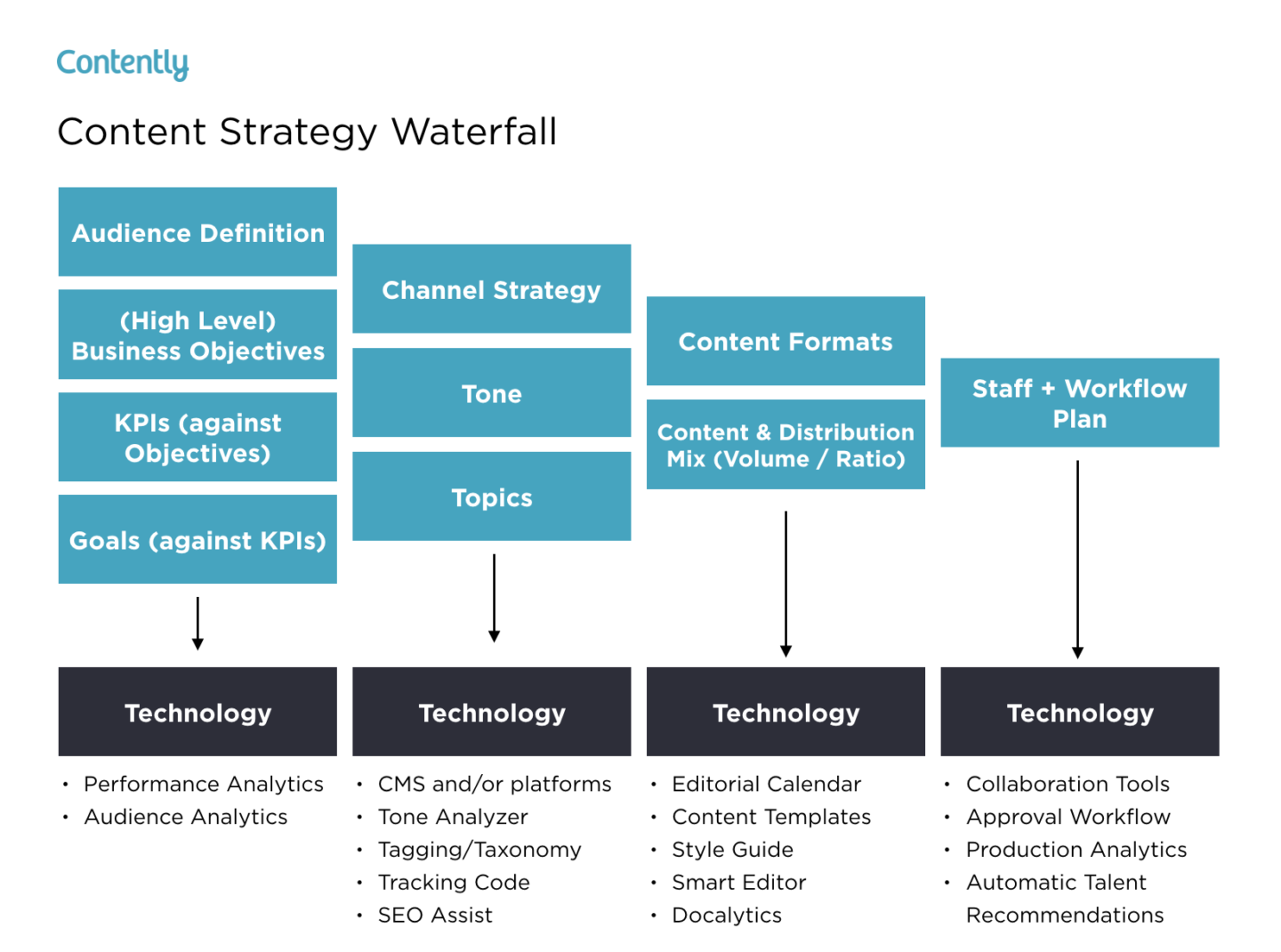
2. Visit Baton Rouge
The Baton Rouge area of Louisiana generates millions of dollars every year from tourism alone. The Visit Baton Rouge marketing plan was born from a need to better position the area and create long-term strategies for generating interest. This 38-page document goes into detail describing different destinations, events, and calendars, including recommended measurements for success.
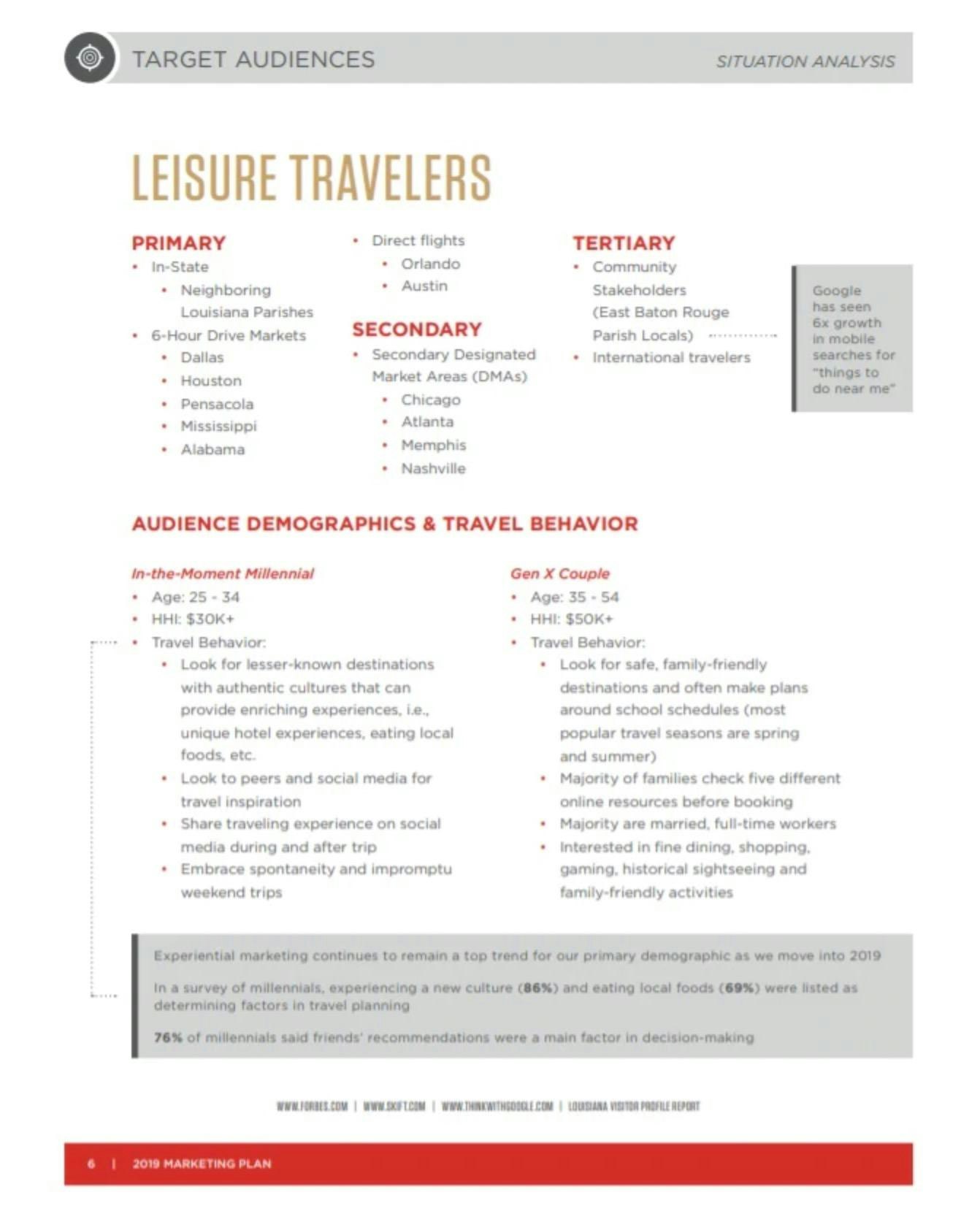
Created by SaaS company HubSpot , this template includes a business summary, SWOT matrix, market strategy, budget, and other important aspects of a marketing plan. By filling it out, you can make informed decisions about your company’s positioning and your marketing in general.
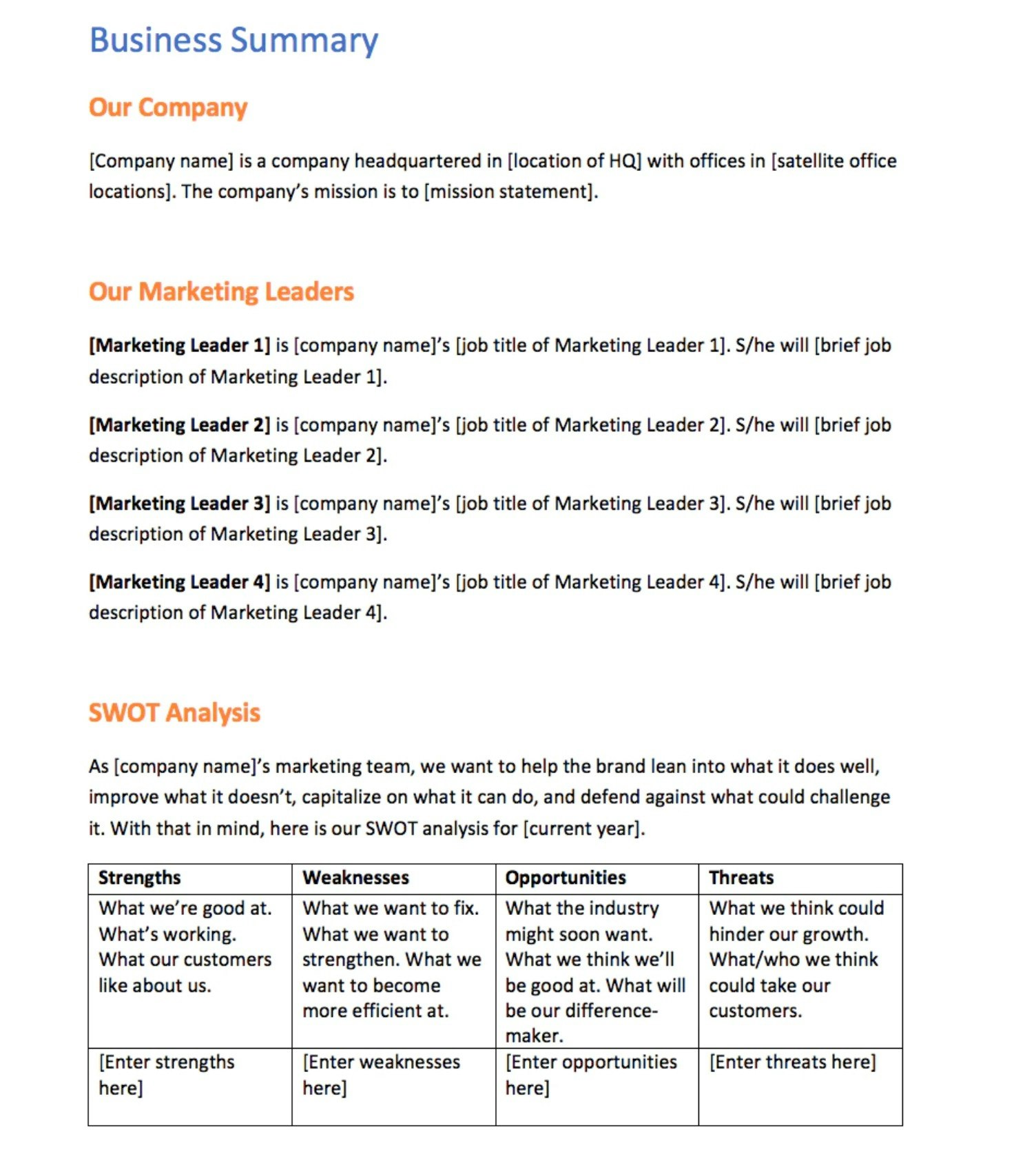
4. Evernote
Evernote provides a comprehensive marketing plan template for businesses of any size. Create a plan that walks through overviews, timelines, research, personas, and all other elements of an airtight campaign. If desired, you can also implement this template into your Evernote account to start developing a marketing plan almost immediately.
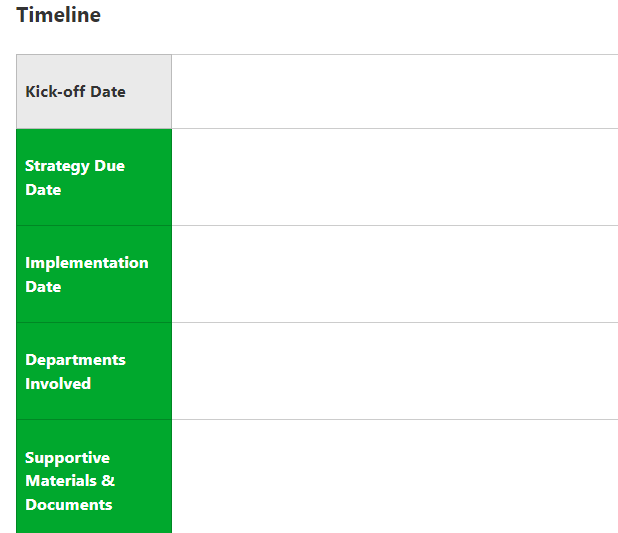
5. University of Illinois
Even educational institutes need marketing plans. The University of Illinois created a very straightforward document that encapsulates its market context, research efforts, and current campaigns. Objectives and success metrics are completed in the third section, with about 40 pages overall.
6. Monday.com
Monday.com is a project management platform providing in-house templates to all active users. This marketing plan offers various categories and subcategories that track project progress with data visualizations. Detailed objectives and KPIs can be identified in-app, including columns for a projected cost range.
Popular health and hygiene brand Lush released a comprehensive marketing plan walking through some products, positioning, and a marketing calendar for upcoming product releases. One of the highlights includes a detailed SWOT analysis with easy to read graphics. This is particularly helpful for brands in the personal care industry, among others.
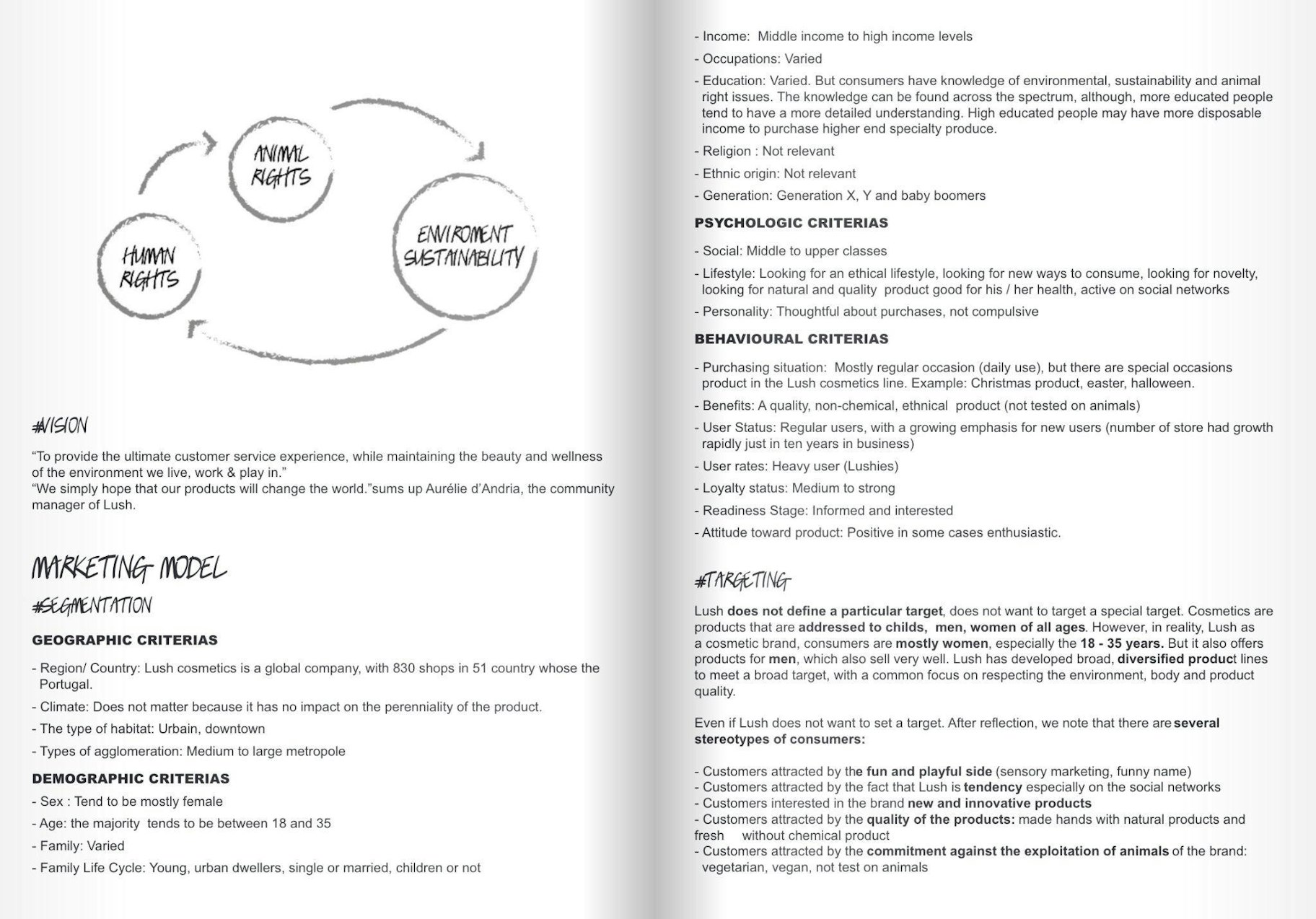
8. Coca-Cola
Industry titan Coca-Cola released a strategy video that encompasses all seven elements of a holistic marketing plan. The proposal primarily explains the major content initiatives for the coming year, and focuses on how the brand’s initial ideas can be practically implemented into the existing strategy.
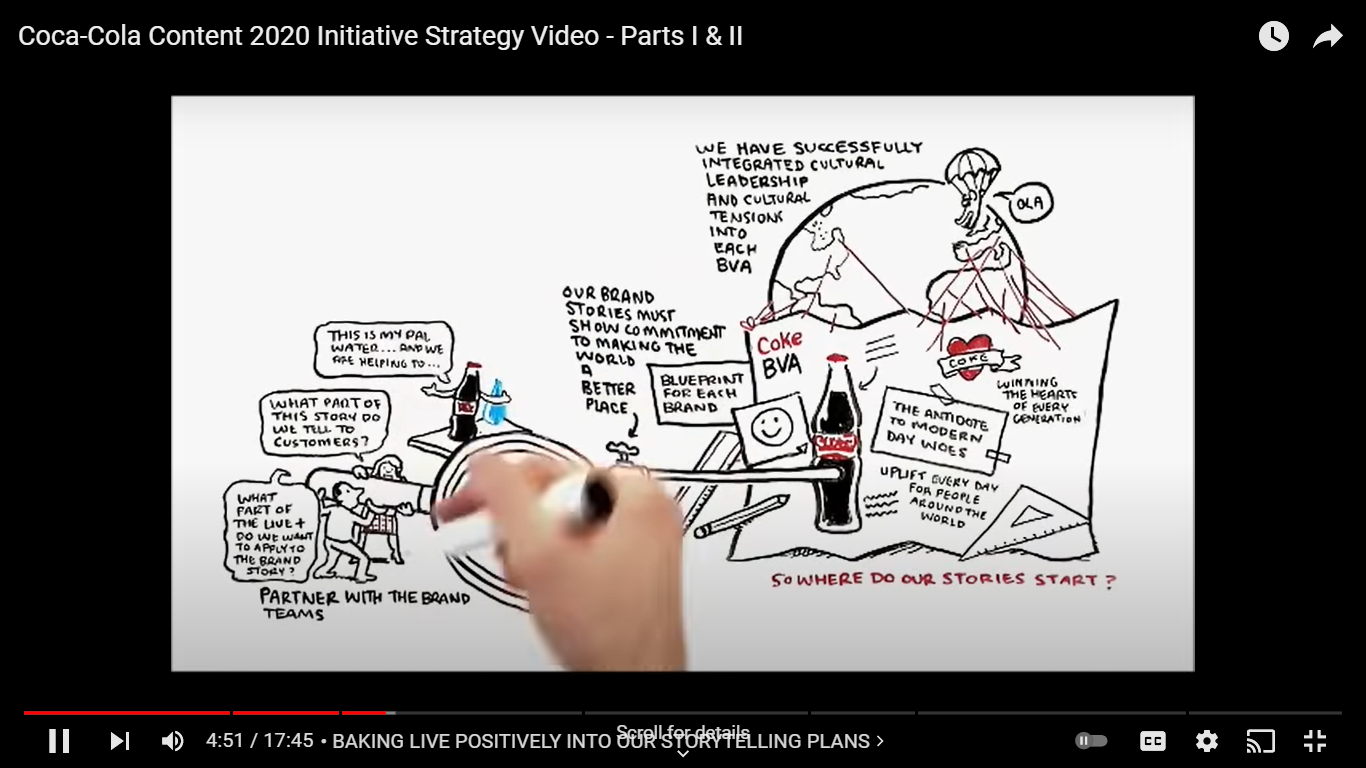
9. Naperville Park District
Publicly funded recreational parks often have limited access to resources, which is why the Naperville Park District created a strategic marketing plan right at the beginning. This extremely detailed document walks through the company’s mission, situational analysis, strategy, and budget, on a micro-level.
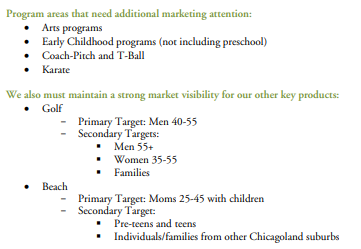
10. Starbucks
Unlike the longform documents we’ve seen already, Starbucks takes a more concise approach. This six-page release details a strategy to elevate CX and brand ambassadors around the world. The marketing plan touches on individual strategies and tactics, as well as the methods used to ensure success. It’s important to note the detailed customer journey profiles that fit into a five-year strategy.
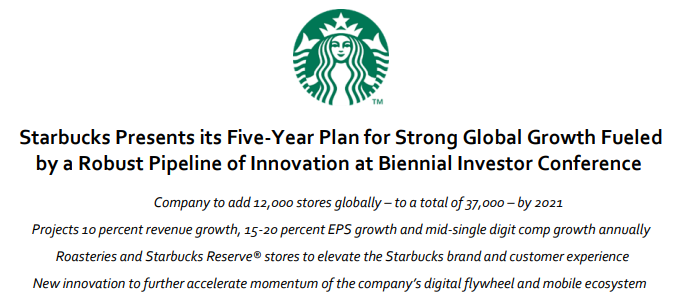
How to approach a marketing plan
Now that you know what a marketing plan looks like, it’s time to explore the initial stages of drafting and publishing your very first plan. Once you establish some basic starting points, a little research is all you need to get started.
Determine your goals
Directions simply don’t matter without an endpoint in mind. Craft some meaningful goals for your marketing campaign that envelop your brand’s values, objectives, and year-end plans. It’s best to use the SMART goal framework:
The more specific your goals are, the more effective your marketing plan will be.
Check your competitors
Staying abreast of your competitors and market share is critical in the early stages of a marketing plan. Using competitive analysis tools or an internal process, take some time to evaluate the approach that others are using — and how you can do better.
You might want to:
- Perform a competitive analysis
- Keep a close eye on industry news
- Browse competitor social media content
Keep in mind that it’s possible to hire freelancers to perform competitive analysis for you, depending on your needs and time constraints.
Identify your audience
Understanding your target market — including their goals, ages, values, and demographics — is the golden rule of marketing. This can be done several ways, either by using data, creating personas, or outlying features in a document.
It’s best to consider everything that may be relevant to your audience in the marketing plan, including how products can be positioned in a way that makes them relevant. For example, a customer with a degree in IT would be more interested in ads that speak to their experience and industry pain points.
If you don’t have a target audience in mind yet, consider using programs like Google Analytics or in-platform insights from Facebook to identify specific segments.
Craft final KPIs
The difference between a good marketing plan and a great marketing plan starts with key performance metrics (KPIs). These will be used to measure the effectiveness of your campaign and provide detailed information about what worked, what didn’t, and what you can change in the future.
Every marketing plan should rely on its own unique set of metrics, all fitted to individual needs. If you’re looking for specific examples, you might want to try:
- Raising the number of followers on a social media account
- Generating a certain amount of website leads
- Achieving higher email open rates
Keep in mind that your final metrics should adhere to the SMART method for best results.
Perform your revisions
The marketing plan is a living document and must be updated regularly to remain current. The average plan only has a shelf life of one to five years , on average, and should receive regular revisions in the meantime.
Take a closer look at your past goals, competitors, audience, and KPIs. Are any of these outdated or ill-aligned? What has changed for the company since its initial publication date? Make these adjustments accordingly (and hopefully with members of a team or committee).
Create marketing plans that guide your business well
It’s not enough to just write a marketing plan. In an increasingly competitive world of iron-clad strategies, marketing pros should take their time developing a plan that lasts. The above examples are a great place to start, especially as you craft an approach that is catered to your industry.
Keep an eye on the growth of your business once your marketing plan hits the shelves. Continue to find new ways to optimize, refine, and otherwise make what you have even better than before. With an airtight marketing plan by your side, the possibilities are virtually limitless.
Want to learn more?
- How to Create a Killer Social Media Marketing Plan
- The Complete Guide to Getting Started With Influencer Marketing
- 7 of the Best Landing Page Examples to Learn From
- Instagram Marketing Tips to Shoot Up Your Sales

10 Best Ecommerce Hosting Providers in 2024
Who’s the best ecommerce hosting provider out there? That’s what this post aims to help you find out.

56 Small Business Ideas To Make Money in 2024
Find a list of 56 small business ideas that’ll make you money in 2024. Thousands of entrepreneurs have implemented them…

The Ultimate Guide to AliExpress Dropshipping
If any of you have doubts that you can create a successful ecommerce business with AliExpress dropshipping, this post w…
Oberlo uses cookies to provide necessary site functionality and improve your experience. By using our website, you agree to our privacy policy.

Do you have the world's best boss? Enter them to win two tickets to Sandals!
- Starting a Business
Our Top Picks
- Best Small Business Loans
- Best Business Internet Service
- Best Online Payroll Service
- Best Business Phone Systems
Our In-Depth Reviews
- OnPay Payroll Review
- ADP Payroll Review
- Ooma Office Review
- RingCentral Review
Explore More
- Business Solutions
- Entrepreneurship
- Franchising
- Best Accounting Software
- Best Merchant Services Providers
- Best Credit Card Processors
- Best Mobile Credit Card Processors
- Clover Review
- Merchant One Review
- QuickBooks Online Review
- Xero Accounting Review
- Financial Solutions
Human Resources
- Best Human Resources Outsourcing Services
- Best Time and Attendance Software
- Best PEO Services
- Best Business Employee Retirement Plans
- Bambee Review
- Rippling HR Software Review
- TriNet Review
- Gusto Payroll Review
- HR Solutions
Marketing and Sales
- Best Text Message Marketing Services
- Best CRM Software
- Best Email Marketing Services
- Best Website Builders
- Textedly Review
- Salesforce Review
- EZ Texting Review
- Textline Review
- Business Intelligence
- Marketing Solutions
- Marketing Strategy
- Public Relations
- Social Media
- Best GPS Fleet Management Software
- Best POS Systems
- Best Employee Monitoring Software
- Best Document Management Software
- Verizon Connect Fleet GPS Review
- Zoom Review
- Samsara Review
- Zoho CRM Review
- Technology Solutions
Business Basics
- 4 Simple Steps to Valuing Your Small Business
- How to Write a Business Growth Plan
- 12 Business Skills You Need to Master
- How to Start a One-Person Business
- FreshBooks vs. QuickBooks Comparison
- Salesforce CRM vs. Zoho CRM
- RingCentral vs. Zoom Comparison
- 10 Ways to Generate More Sales Leads
Your Guide to Creating a Small Business Marketing Plan

Table of Contents
To have a successful business, you need a well-thought-out marketing plan to promote your products or services. Although making a few social media posts or blasting a few promotional emails may seem simple enough, disjointed marketing efforts not only confuse your target audience, but can ultimately harm your business.
What is a marketing plan?
A marketing plan is a strategic road map for how you communicate (online and offline) with your target audience to successfully promote your products or services. Depending on your goal, marketing plans can be extremely basic or highly detailed.
According to Molly Maple Bryant, vice president of marketing at Vibrent Health, a marketing plan is not simply a list of things you want to accomplish. Instead, it should list the outcomes you seek — measurable and contextual, like the pipeline you’re developing, or leads you’re generating — and it should explain the high-level strategies you will use to achieve those outcomes. Developing strategies can be complicated, but they make a major difference in keeping you on track and avoiding diversions, also called scope creep .
“Once you have an agreed-upon plan, you are able to compare any incoming requests against your strategies to determine ‘Yes, this adheres to my strategy so we can add it,’ or ‘No, this sounds good in theory, but it doesn’t adhere to our agreed-upon strategy, so we won’t adjust resources,'” Bryant told us.
Download a copy of our free marketing plan template .
Types of marketing plans
There are several different types of marketing plans you can use based on certain strategies that make sense for your organization. Your business will likely need a combination of the following marketing plans to create an effective, comprehensive marketing strategy:
- Advertising plan
- Branding plan
- Content marketing plan
- Customer acquisition plan
- Direct marketing plan
- Email marketing plan
- Public relation plan
- Print marketing plan
- Reputation management plan
- Retention plan
- Search engine optimization plan
- Social media marketing plan
Depending on your product positioning, niche marketing plans like influencer marketing or video marketing can be incredibly effective.
Why is it important to have a marketing plan for your business?
A marketing plan is a crucial resource for any small business because it helps you identify the market needs your product or service meets, how your product is different from competitors, and who your product or service is for. Marketing plans also serve as a road map for your sales strategy, branding direction and building your overall business. This is important for successfully conveying your brand messaging to your target audience .
Another significant benefit of a marketing plan for your company is that rather than simply guessing metrics, it forces you to sit down and do the math about your business goals and how to realistically fulfill them. When you look at your growth outcomes, you can delve further to determine what it will take to get to those numbers.
Bryant offered the following example: “Need $100,000 in revenue? How many sales is that? If 10, what’s your close rate? Let’s say 10 percent from lead to closed deal. Now you have a metric to start with — to get to 10 sales, we need 100 leads. Where will they come from, and what strategies will you use? The plan helps you put it all on paper so you can map out resources and tactics later with a lot of preparation and realism,” said Bryant.
When analyzing outcomes and resources, you can save time and avoid scope creep by focusing only on strategies that are relevant to your marketing plan. A marketing plan helps you think realistically about your strategies, gets your stakeholders on the same page, and holds your marketing team accountable for their decisions.
“When everyone’s tasks and goals are laid out for the stakeholders and company partners to see, it is much easier for the entire team to feel at ease about reaching sales goals and allowing the marketing team the space and freedom needed to execute work without constant supervision,” said Cassady Dill, digital marketing consultant and owner of Ethos Agency.
Additionally, Dill said a marketing plan should be easily understood by your entire team, executives and outside departments. Your plan should also serve as an easy guide for future marketing managers and team members to understand and implement.
What are the key elements of an effective business marketing plan?
A marketing plan should be customized to fit your business; however, Dill said, all marketing plans contain five essential functions:
- Your business goals
- Key metrics (how you quantify and measure success)
- Strategies (an overview of implementation and how that will achieve goals)
- A plan (the details of execution and the human resources, departments and software that will be involved)
- Reporting (what reports of progress will include and/or look like)
We broke down those five functions into 10 actionable categories to help you create a marketing plan that is unique and effective for your business.
1. Executive summary
The executive summary is a great place to give the reader of your plan an overview of your business’s mission or goals, as well as the marketing strategy you’re looking to employ. An executive summary is often written after you’ve completed the rest of the marketing plan, to ensure it covers all the important elements of your plan. If the executive summary is the only part of your marketing plan that someone reads (which is highly possible), you want to be sure they understand the most crucial details.
2. Mission statement
The mission statement , not to be confused with a vision statement, is a statement that encompasses your company’s values and how they relate to your overall goals as an organization. Here are some good questions to get you thinking:
- What does your company do today?
- What’s important to your company?
- What would your company like to do in the future?
- What is your brand identity?
- What’s your culture like ?
- How does your company benefit customers, employees and stakeholders?
3. Target markets
Identifying your target market is one of the most important parts of your marketing plan. Without a defined target audience, your marketing expenses will be wasted. Think of it like this: Some people need your service or product but don’t know it exists yet. Who are those people?
Here are some other questions to help you brainstorm your target market :
- What is the demographic of your customers (gender, age, income, education, etc.)?
- What are their needs and interests?
- What’s their psychographic profile (attitudes, philosophies, values, lifestyle, etc.)?
- How do they behave?
- What are some existing products they use?
4. Products and services
In this section, don’t just list what your product or service is. Think critically about what you have to offer your customers and what that value proposition means to them.
- What do you make or provide for customers?
- What are your customers’ needs?
- How does your product or service fulfill customers’ needs?
- What value do you add to your customers’ lives?
- What type of product or service are you offering?
5. Distribution channels
At this point in your report, you should transition your thinking into actual marketing theory and practices. Distribution channels are the avenues you’ll use to reach a prospective customer or business . Think of all current and potential sales channels on which your specific target audience is active. One distribution channel that works great for one organization may be useless to another. For example, one company may host their website for free on a site like HubSpot and solely rely on that as their sales channel, while another company may have a whole team of people using Pinterest to drive sales. [Learn how CRM systems can help track your marketing leads based on various distribution channels.]
Examples of sales channels include the following:
- Mobile text message marketing
- Social media
- Print (newspapers, magazines, brochures, catalogs, direct mail)
- Broadcast (TV, radio)
- Press releases
- Trade shows, product demonstrations, event marketing
6. Competitive profile
One of the major aspects of your marketing plan is developing your unique selling proposition (USP). A USP is a feature or stance that separates your product or service from competitors. Finding your USP is all about differentiation and distinguishing your company as a sole proprietor of one type of good or service. Conduct a competitive analysis to identify your competitive profile and how you stack up against the competition. It is important to remain unbiased when conducting this analysis.
Here are some ideas to consider:
- What’s your USP?
- Who are your competitors? What do they offer?
- What are the strengths and weaknesses of your competition?
- What needs of the market (or customer) are not being served? What can you do to meet those needs?
If you are creating your USP for the first time, here are seven surefire strategies to help you stand out from the competition .
7. A pricing strategy
Consider pricing when drafting your marketing plan. Developing the right pricing strategy helps you better market your product. Think about your current and projected finances when developing a long-term marketing strategy that is realistic and beneficial for your business. Here are some key questions to ask yourself about your pricing:
- What are reasonable margins to make a profit and cover production costs?
- Is there a market for products or services at your projected price point?
- Are you willing to sacrifice profit margins in return for a greater market share?
- What are your marketing and distribution costs?
8. Objectives
Consider your objectives when developing a marketing plan. This aspect of your plan should involve specific goals related to market penetration and revenue targets. Be sure to keep your marketing objectives on-brand with your business. Here are some things to consider:
- Sales quotas
- Number of new customers gained
- Customer retention percentages
- Revenue targets
- Market penetration
- Brand awareness
- Website traffic
9. Action plans
With all of the above items outlined, determine what steps need to be taken to enact your marketing plan. This includes determining the proper steps, setting goals, breaking down responsibilities, and establishing an overall timeline.
It’s also important to brainstorm potential roadblocks your business could face and some solutions to overcome them. Your research is useless if you don’t have an actionable plan that can be realistically implemented to carry out your ideas.
10. Financial projections
This last step allows you to establish a realistic marketing budget and better understand your marketing plan from a cost perspective. In addition to setting a budget, consider the overall return on investment as well. Here are some other financial projections to consider:
- Cost of implementation
- Cost to produce product or service
- Existing and projected cash flow
- Projected sales
- Desired profit margin on projected sales
What is a template for creating a successful marketing plan?
The internet is full of useful tools, including paid and free marketing plan templates, to help you build a successful marketing plan .
Whether you are looking for a free template generator to build a new marketing plan or a benchmarking tool to evaluate your current strategies, several great resources are available. Keep in mind that the best marketing plan for your business will be a customized one.
“Ultimately, you should design a marketing plan that best serves the needs of your team as you see fit,” said Dill. “Don’t force yourself into a plan that doesn’t fit your team. Use templates to shorten the workload time, but then adjust it for a more custom plan.”
Here are some tools and templates to get you started:
- Free marketing plan template : business.com has developed a free template that is fully customizable based on the needs of your business. Each section provides in-depth explanations, examples and resources to help you create an impressive marketing plan.
- Smart Insights: In addition to offering marketing plan templates, some companies, like Smart Insights, offer marketing benchmarking templates to help you evaluate your strategy performance. These are accessible with a free Smart Insights membership.
- GERU: Similarly, GERU offers a funnel-planning, profit-prediction and simulation tool to help you assess mock business ideas and simulations. This can help you identify weak points in your marketing strategy that need improvement. Although GERU requires users to sign up for a paid account, you can access a free trial to test it out.
What mistakes should you avoid when creating your marketing plan?
When creating an effective marketing plan, you need to avoid falling for common missteps and mistakes. For starters, failing to identify any of the 10 actionable categories above is an obvious mistake.
Here are some other key mistakes to avoid:
- Setting unrealistic budgets: Underestimating the costs of marketing activities or setting an unrealistic budget can limit your ability to execute your plan effectively. Marketing can be expensive, so it’s important to fully understand the estimated cost and budget before building a marketing strategy that you can’t afford.
- Focusing on quantity over quality: “More” doesn’t always mean “better” if you are posting on irrelevant marketing channels or your efforts are bringing in unqualified leads. Prioritizing the quantity of marketing activities over their quality can lead to superficial engagement and a lack of meaningful results.
- Not testing campaigns: Launching large campaigns without testing can lead to wasted resources if the messaging or tactics don’t resonate as expected. Test out your new campaigns to ensure they achieve your intended goal.
- Ignoring customer feedback: You may be tempted to ignore negative feedback, but disregarding customer comments and failing to address their concerns can lead to negative perceptions of your brand. Instead, use customer feedback to your advantage to improve your product and marketing efforts.
- Overpromising and underdelivering: Setting unrealistic expectations in your marketing messages that your products or services can’t fulfill can damage your brand’s reputation.
- Ignoring seasonality and trends: Failing to account for seasonal trends and market changes can result in missed opportunities for timely marketing efforts.
- Not reviewing and updating your plan: A rigid marketing plan that doesn’t allow for adjustments in response to market feedback and changing conditions can hinder your success. A marketing plan should be a living document that is regularly reviewed and updated to reflect changes in the market and your business’s goals.
Avoiding these mistakes and missteps can help you create a more effective and successful marketing plan that drives results for your business.
How can you take action with your new marketing plan?
Before you dive into marketing plan templates, it’s important to understand how to think about a marketing plan.
A good marketing plan targets who your buyers are, establishes the service or product you are offering, and determines your unique selling proposition. From here, you will tackle the marketing planning process and develop the best way to get your product in front of buyers who want your product or service.
Dill created a simple four-step process for how small businesses can take action with creating a marketing plan.
- The first step is to hold a marketing meeting with all the marketing team and executives or stakeholders. This gives them time to offer questions, concerns and criticisms you haven’t thought of so you can go back to the board room and revise your strategy or plan.
- Next, add a timeline to all your tasks and assign team members and all the help you’ll need to execute that plan.
- Once your plan is in action, hold weekly check-ins in person or by email to keep everyone on track.
- Share a weekly progress report with all parties involved and execs to ensure you are moving in the right direction.
In addition to drafting your own plan, you can work with a digital marketing agency or use internet marketing and pay-per-click management services to leverage your online presence.
Once you’ve established a general road map, update it annually. Developing an evolving marketing plan sets your business up for continued success because it allows you to prepare for the unexpected and establish a connection between your brand and your audience.
Matt D’Angelo contributed to this article. Source interviews were conducted for a previous version of this article.

Get Weekly 5-Minute Business Advice
B. newsletter is your digest of bite-sized news, thought & brand leadership, and entertainment. All in one email.
Our mission is to help you take your team, your business and your career to the next level. Whether you're here for product recommendations, research or career advice, we're happy you're here!

- Share on Twitter
- Share on LinkedIn
- Share on Facebook
- Share on Pinterest
- Share through Email
How To Create A Small Business Marketing Plan In 9 Simple Steps (with Templates)
A small business can use a marketing plan to guide their entire marketing efforts. Follow our step-by-step roadmap to reach your business objectives, increase revenue, and grow your company.

Imagine there are two T-shirt companies. Their shirts are both handcrafted and are of the exact same quality and style.
T-shirt seller A has never created a marketing plan and strictly relies on word of mouth to sell their shirts.
T-shirt seller B has put plenty of time into its marketing efforts. They’ve created a website, uses a variety of digital tools, posted regularly on social media , and even built an email list.
Which company do you think sells more shirts?
Regardless of the size of your company, the core marketing principles are the same. Even if you have a small business, you can create a marketing plan to help you grow your business. In fact, the smaller your business is, the more important it is to put time and energy into creating a marketing roadmap.
In this in-depth guide, we’ll cover everything you need to know about creating a small business marketing plan to help you reach your goals. We’ll break down the nine simple steps you need to take to craft a marketing plan that works in the digital age. Plus, you’ll get a template you can follow to craft your own strategy and some best practices to follow to ensure it’s a success.
What Is Small Business Marketing?
Small business marketing is the process small businesses use to get their products and services in front of potential customers to generate sales. This type of marketing typically includes a variety of marketing channels, disciplines, and tactics to gain exposure.
The primary goal of small business marketing is to not only connect with new prospects to acquire new customers but also to build and nurture relationships with existing customers to keep them coming back.
Small business marketing can consist of a variety of offline and online strategies . Regardless of the marketing tactics you use, the end goal is typically to generate more revenue, expand market share, improve profitability, and grow.
What Is a Small Business Marketing Plan?
A small business marketing plan is a roadmap small businesses can use to reach their marketing objectives, increase revenue, and grow their overall business. A small business can use a marketing plan to guide their entire marketing efforts to ensure they meet their company’s objectives.
In 2021, the most prominent small business marketing challenges were:
- Not having enough time and resources to focus on marketing
- A small marketing budget, and
- Lack of clear marketing strategy and objectives
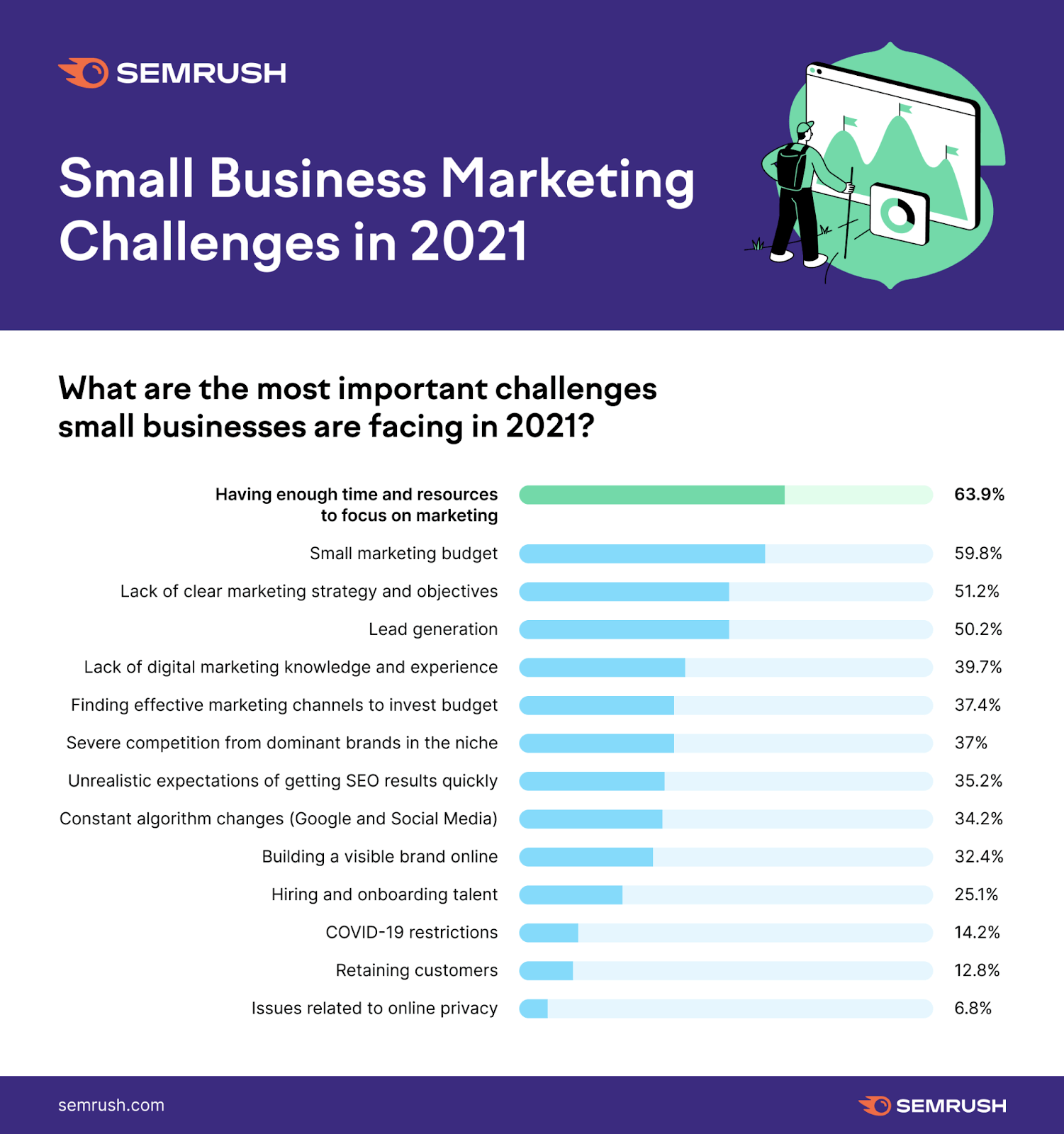
Without a clear marketing strategy and objective, your marketing efforts will be a waste. But, if you implement a small business marketing plan, you’ll be well to see your company or department succeed.
9 Steps to Create a Small Business Marketing Plan
Every small business marketing plan will be different as each business is different. But there’s a simple framework you can use to come up with a plan that’s actionable and effective. Follow these nine steps to set your marketing team up for success:
1. Establish your goals
First off, you need to set your marketing goals. But you can’t just set a random, vague goal like “Make more money.” You need to set clear, actionable goals.
The best way to come up with marketing goals is to use the “SMART” formula. This stands for:
- S: Specific
- M: Measurable
- A: Achievable
- R: Relevant
- T: Time-bound
The SMART goal strategy is a tried and true method of goal setting to help you achieve what you’re aiming for. Here’s an example of a SMART small business marketing goal:
“Increase return customer rate from 5% to 20% in 12 months.”
Let’s see how it lines up with the SMART formula:
- S: Specific (about retention)
- M: Measurable (includes real numbers)
- A: Achievable (not too far out of reach)
- R: Relevant (aligns with your overall business objectives)
- T: Time-specific (in 12 months)
If you’re having trouble coming up with your goals, you could start by identifying some broader small business objectives before getting specific.
Here are a few common small business marketing goals:
- Build a greater online presence
- Generate more leads (and customers)
- Increase brand awareness
- Connect with a broader audience
- Engage with your audience more
- Generate more recurring revenue
It’s up to you to figure out which of these goals makes the most sense for your team and your business. Try and come up with 3-5 SMART goals now and write them down.
2. Understand your target audience
Now that you’ve established your primary marketing goals, it’s time to focus on your audience. Ultimately, they’re going to be the ones to help you reach your goals.
Before you can achieve any sort of success with your marketing efforts, you need to know who you’re targeting. Your target audience can vary based on a variety of different factors like geographical region, your business type, and demographics.
Oftentimes, your audience will dictate the type of marketing tactics you implement later on, so it’s crucial you take the time to research so you can understand them better.
For instance, if your target audience is in their 70s, then TikTok might not be the best place to invest your marketing resources. On the other hand, if you’re targeting Gen-Zs, then you should probably avoid print ads and, instead, get on TikTok and Instagram asap.
Here are a few questions you should ask yourself to help understand your audience:
- Who are your past customers? Look at demographics like age, location, and gender.
- Who are your returning customers? This is important to understand, especially if one of your goals is to generate recurring revenue through increased retention.
- Who do you want to reach? While you may have a specific past customer base, it’s crucial to know the type of customer you’re after so you can adjust your marketing strategy to target them better.
- What products or services are people buying from you the most? Look at sales data to help understand what your customers are interested in, their pain points, and the problems they’re looking to solve.
- Why did your past customers buy from you? Look into primary driving factors for their purchase decisions. You can email customers directly, conduct surveys, and look at reviews and testimonials to understand the intent behind their purchases.

Stay Up-to-date On All Things Marketing & Leadership.
- Your email *
- No spam, just quality content. Your inbox is safe with us. For more details, review our Privacy Policy . We're protected by reCAPTCHA and the Google Privacy Policy and Terms of Service apply.
- Name This field is for validation purposes and should be left unchanged.
3. Set your budget
Now that you’ve set your goals and understand your target audience, it’s time to establish your marketing budget.
You should take the time to assess the current financial health of your business—including your current and future cash flow—to determine your marketing budget. If you’re not running the finances in your small business, sit down with your CFO to come up with a budget you can both work within.
It’s crucial to figure out your budget ahead of time, as it’ll help guide the remainder of your marketing plan.
You should be realistic about how much money you’re able to invest into your marketing efforts every month.
If you’re scratching your head wondering where to start, you can start with around 10-20% of your overall revenue. This is a typical budget allocation for small businesses to invest in their marketing efforts.
While this may seem like a lot to invest, the return on investment (ROI) will be well worth it (if you implement the right marketing plan).
If you’re thinking you have almost nothing to spend on marketing as you’re brand new, that’s alright! Any little bit helps. Whatever you can invest in your marketing will help fuel future business growth.
Don’t forget that when budgeting, you should also take into consideration your time budget. In other words, you should look at not just the money you can put into marketing but the overall resources, including work hours. How much time are you able to devote to your marketing strategy every day, week, or month?
Write it down alongside your monetary budget. It can be easy to let other business activities take priority over your marketing efforts. Make sure you craft a time budget as well to ensure your marketing gets done. This will help you see your goals through to the end.
4. Create a website
Now that you’ve set your time and money budget, it’s time to spend it!
This is the fun part (at least for most people). Now that you know what you’re working with in terms of your resources, you can get to work on your marketing.
Your website is the digital headquarters for your business. It’s the place where you establish your branding, where you convert prospects into leads, and where you generate new sales.
You need to ensure your website is both professional and tactical. It’s the place where you show off who you are and what you offer. It’s the place of first impressions, so you need to ensure it’s designed well and functions in alignment with your goals.
The most effective websites will be much more than a digital brochure. When crafted properly, they can be 24/7 salespeople for your business.
If you have the budget, you should hire a web designer and developer to help you craft a professional site. If you have a limited budget, there are plenty of cheap and free website-building tools you can use to create your own site, even if you know nothing about design or coding.
5. Build a social media presence
Now that your headquarters is established, it’s time to set your brand up on social media. Nowadays, social media is an essential part of any small business marketing plan (whether your business is online or offline). The reality is that every type of customer is on social media (regardless of age).
If your audience skews younger, then chances are they’re on TikTok, Instagram, and Snapchat. If they’re older, they’re likely on Facebook. If you have a B2B brand, then you might want to check out LinkedIn.
You probably think all the different platform choices are overwhelming. You’re right—it can definitely be a confusing process trying to figure out how you’ll manage to post on dozens of social platforms consistently.
The truth is, you don’t have to, and you shouldn’t—at least not at the start.
The best way you can get started with your social media plan is to focus on one platform (two at max) when you’re first starting out. Take a look back at number two—your audience. Where are they? Chances are, they hang out on one social media platform more than the others. Try to determine where they hang out. If you’re unsure, you can conduct surveys, ask customers one-on-one, or you can try testing out paid ads on a few platforms to see if there’s a winner early on (we’ll touch more on this at number 7).
There are two secrets to winning with social media:
- Post consistently.
- Engage with your followers.
That’s it. Yes, there are dozens of other tactics you can use to increase your social media marketing efforts. But you should spend 80% of your social media efforts focusing on these two things—especially when first starting out.
Just remember: Even if you’re not going to start posting regularly on all the additional social media platforms, it’s important that you at least make a profile on each one to establish consistent branding if you do decide to branch out to them in the future.
6. Create content
Ever heard the term content marketing? It’s one of the most powerful forms of digital marketing in 2023. While content marketing primarily refers to blog posts and articles that help drive traffic to websites, it encompasses a wide variety of different mediums and content types.
In 2021, video content actually surpassed blog content in terms of the type of content created in content marketing strategies.
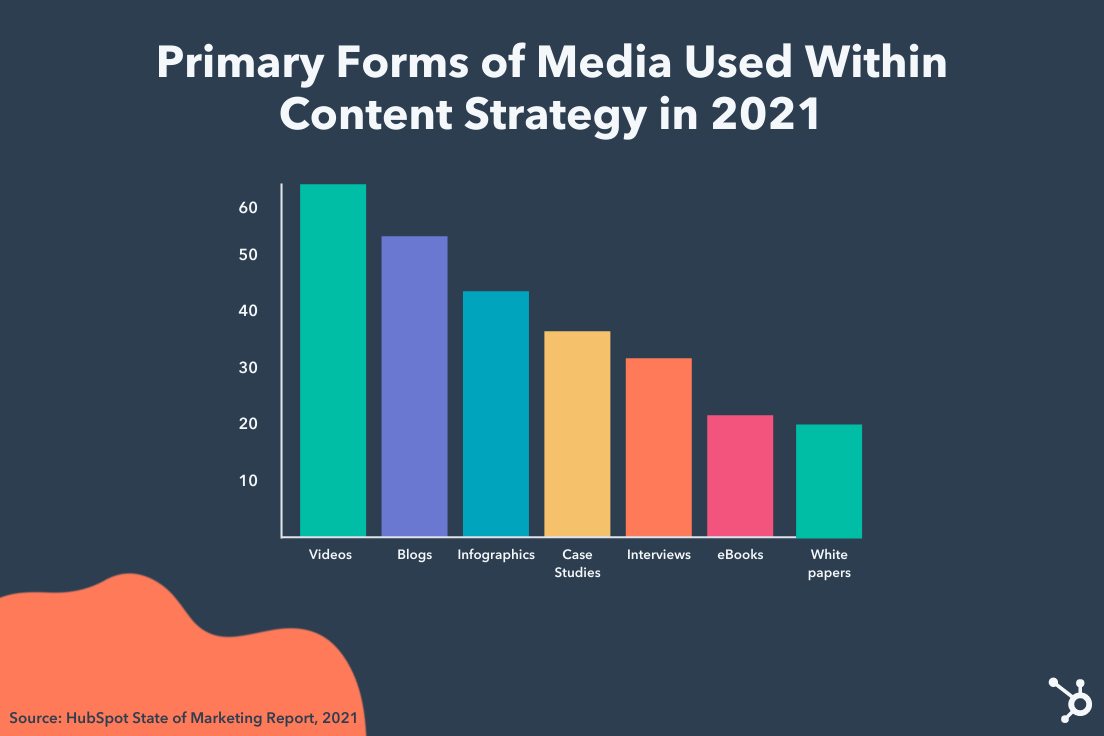
Businesses primarily use content marketing as part of an overall inbound marketing strategy—which includes creating content as a means to draw people to your site. Inbound marketing is all about providing your potential customers with helpful information and resources and providing value that both attracts and converts them into customers.
Nowadays, your content marketing strategy can include a variety of content types:
- Social media marketing
- Video content
- Blog posts and articles
Similar to choosing a social media platform, it can be confusing where to start with content types. You should consider two things: the ways your audience consumes content and the content you like producing.
For instance, you may find that your audience loves video content the best, and they hang out on YouTube and Instagram. But you’re really not into creating long-form videos. Instead, you could create stories on YouTube and Instagram—short-form videos you like creating that also engage your audience.
Just remember, it’s more important to consider how your audience likes consuming content than what you actually enjoy creating. If you despise writing but you know your audience loves reading blogs, then you may want to outsource your content writing or hire a content agency to help you create content.
7. Invest in paid ads & influencers
All the marketing tactics we’ve mentioned above so far are primarily longer-term tactics to grow your audience and build a brand for the long haul.
However, there are two primary marketing tactics you can use to grow your audience and convert customers quickly—if you have the budget.
Those two are paid ads and influencers.
With enough money, you can access any audience. This could be paying for Facebook ads, or it could be paying an influencer to review your product to their audience of 300,000 engaged followers.
Either way, if your goal is to grow or convert new customers quickly, then you can leverage paid ads, influencers, or a combination of the two to reach your goals. To get started, you don’t need to have tens of thousands to spend. With even the smallest of budgets, you can focus on micro-influencers and run pay-per-click ads on Google or Instagram.
8. Consider traditional marketing tactics
The world, in 2023, is super digital. Everyone has a digital marketing strategy. You can use that to your advantage. As digital marketing has become the dominant form of marketing over traditional efforts, traditional marketing has become less expensive and less crowded.
A well-rounded small business plan will often include both online and offline marketing strategies. If you want to diversify your marketing efforts, then you may want to consider implementing some traditional tactics as well, such as:
- Print advertising
If you have a business that’s primarily targeting a local audience, then you will definitely want to consider some of these tactics. These traditional marketing efforts can be incredibly powerful for community and brand-building. If you have a brick-and-mortar store, then implementing at least a few of them is essential to thriving in your community.
9. Track & measure your results
Now that you’re taking action and working on the different marketing tactics outlined in this comprehensive plan, it’s time to focus on perhaps the most important step of them all: tracking and measuring your results.
This is a critical step—and one that will essentially evaluate how close you are to your targets set in step number one. Did you reach your goals? Did you surpass them? Did you fall short?
If you want to succeed with your marketing plan, you need to analyze your efforts. You may be posting on Facebook every day only to get a couple of likes here and there. Or maybe you've built a blog that’s generating thousands of visitors every month.
Perhaps your in-person workshops have turned into a thriving repeat customer base.
You should go back to your original goals at the end dates you set for them (since you crafted SMART goals). Where did you land? If you didn’t reach your goal, analyze why. What tactics and specific steps of action did you take (or not take).
What channels are serving you the most?
What channels are performing the worst?
The best way to close out step nine is to re-establish new goals and essentially start your marketing plan over again. Except this time, you’re not starting from scratch. You’ve built up a solid plan and simply need to shift course a bit. You’ve seen what’s working and what’s not, so you can allocate more time, money, and resources to improve your plan even more.
Remember, building your marketing plan isn’t a one-time event. The best small business marketers know that continually monitoring their efforts and optimizing them is how they will find success in the long term.
Small Business Marketing Plan Templates
If you’re looking for a marketing plan template , you can follow steps 1–9 above to create your roadmap. But, if you want something easy—where you can simply fill in the blanks, then there are hundreds of free or paid marketing plan templates available online.
Whether you’re looking to start from scratch with a comprehensive marketing plan template or a simple one-page template, or you want a practical project-based roadmap, there are plenty of resources available.
Comprehensive marketing plan template
Business.com created a free marketing plan template you can use built right within Google Docs. It’s a comprehensive template you can use to build your marketing plan in a day. Each section includes in-depth explanations as well as free resources to learn more so you can build a clear roadmap.
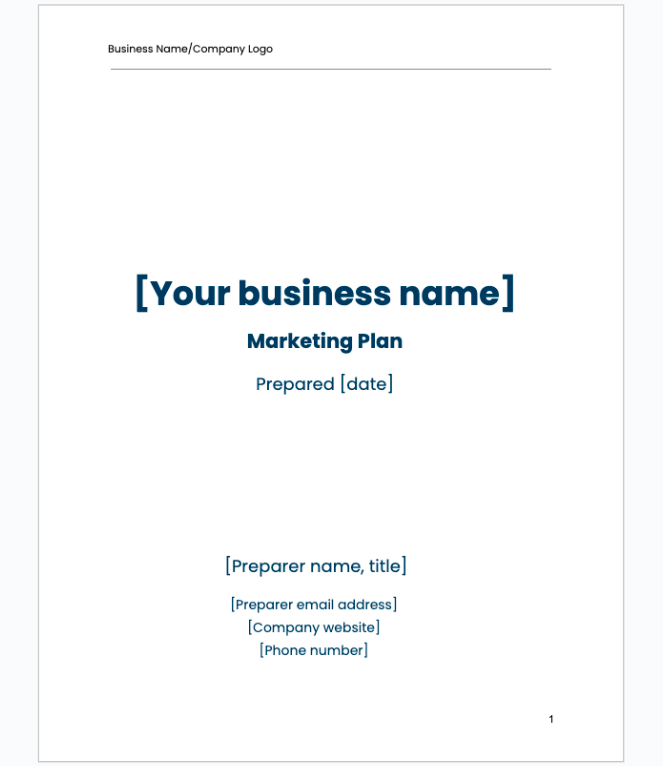
One-page marketing plan template
If you don’t have a lot of time available to work on an in-depth plan, then you’ll want to consider Smartsheet’s template. Smartsheet offers a ton of free marketing templates, including a simple one-page marketing plan that you can get done in under 30 minutes.
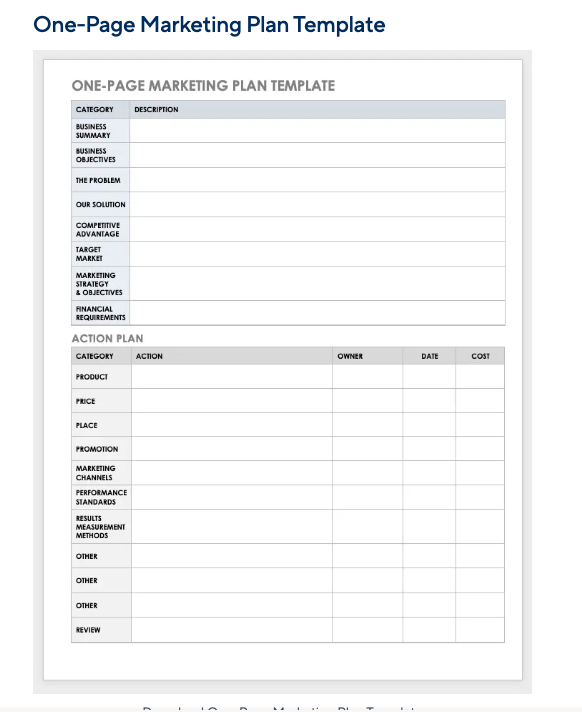
Project-based marketing plan template
If you’re looking for a template that’s more of an action plan for your upcoming campaigns, then you’ll want to check out Monday.com’s marketing plan templates . While you’ll have to get a paid plan to use Monday.com, you get access to a variety of impressive marketing plan templates that are project-based and actionable to help you meet your goals.
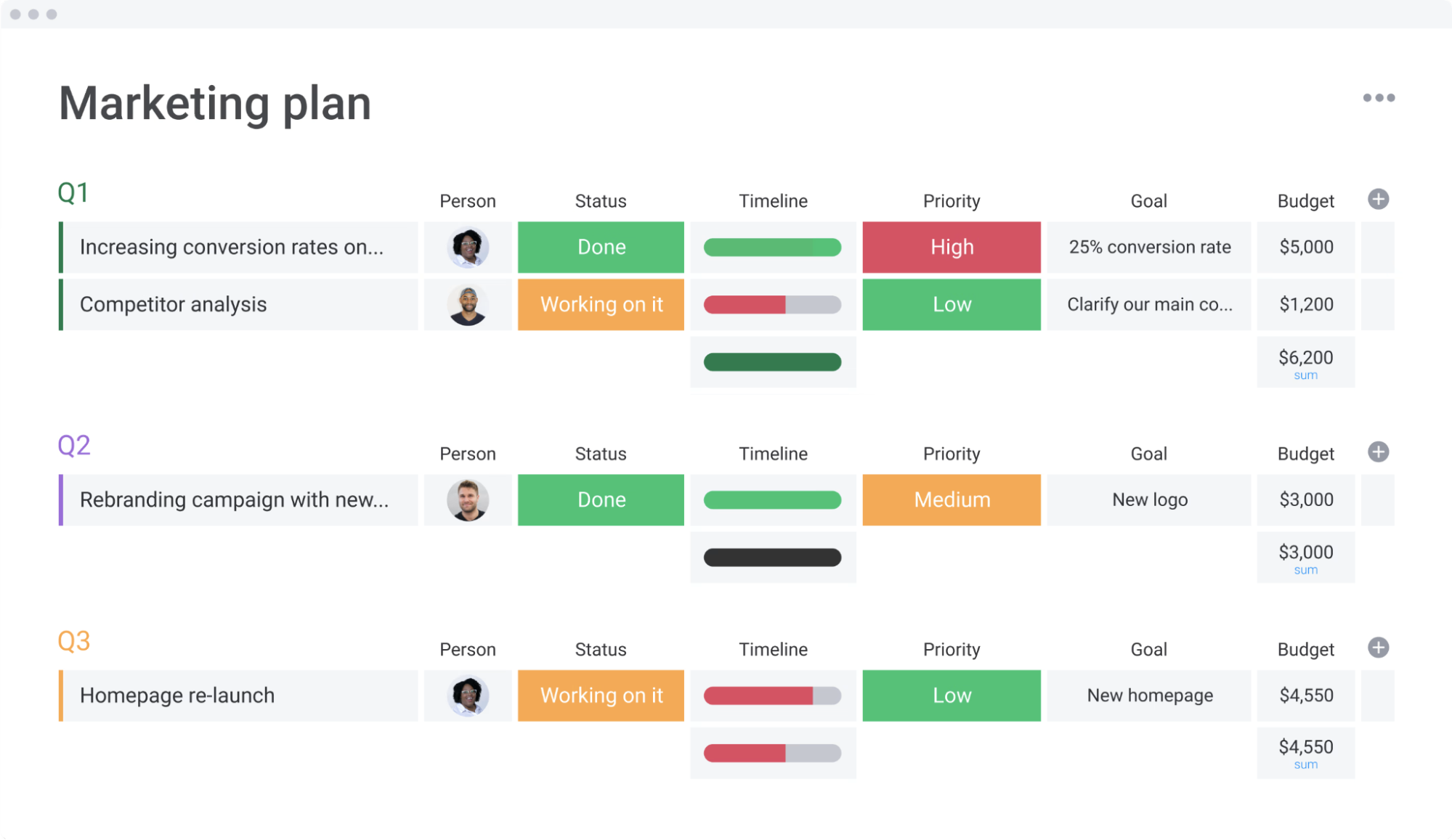
4 Best Practices When Crafting a Marketing Plan
1. center everything around your value proposition.
What makes you stand out from the crowd? Why should customers choose you over the competition?
When building your marketing plan, you always need to keep your value proposition top of mind. It has to take center stage when crafting every piece of content, creating new campaigns, and establishing your buyer personas.
Your value proposition is the thing that differentiates your brand from others in the space. If you’re not sure what yours is, try looking at what you do better than everyone else in your industry. If you can’t figure it out, then you need to establish the thing that does make you different. It could be your product, customer service, content plan, branding, or even price.
More Articles
11 marketing campaign types to try (+ examples and tips), target account list: how to build your list in 5 steps, how to build a personalization strategy (+ tactics & tools), programmatic abm: what it is and how to use it, 2. stay focused on your primary goals.
There are dozens of different paths you can take with your marketing. Within the marketing world, it can be easy to get distracted by new, shiny marketing tactics that are “guaranteed” to convert. While it can be tempting to give in to them, it’s best to stick to your core tactics.
Once you have your marketing plan set up, you need to stick to it to ensure the highest odds of success in reaching your goals. Once you’ve reached your primary objectives (or you’re on the trajectory to do so), then—and only then—should you even consider shifting your marketing efforts to other tactics.
3. Be consistent with your branding
Your branding is your business, and your business is your branding.
When it comes to building the right marketing plan, it’s important to measure the results of your efforts. One of the more challenging aspects of marketing success is measuring how well you are branding yourself. How powerful is your brand?
Your brand image has the power to turn customers off forever with a bad first impression or create raving fans who tell all their friends to buy from you.
One of the key elements to establishing your branding is to ensure you’re consistent. You need to know what type of brand you want to be, then ensure you’re congruent with it everywhere—on your website, social media, ads, in your voice, and even in your customer support.
4. Build a tool stack
In the digital age, you’ll only get so far with your marketing plan without the right tools. Even if you don’t consider yourself tech-savvy, you need to have the right technology at your disposal in order to make a dent with your marketing—even if you lean heavily on traditional marketing tactics.
Here are a few different types of marketing tools you should consider using:
- Marketing strategy software
- Email marketing software
- Content marketing software
- Social media software
- Project management software
- Analytics software
If you have a lean budget, don’t worry. There are plenty of tools in nearly every tool category that won’t cost you a thing.
Level Up Your Marketing Strategy
No matter how great your product or service is, you won’t be able to create consistent growth without a proper marketing plan.
Remember, marketing plans with the greatest odds of success start with the end in mind. Stay focused on your business objectives, and pay attention to what’s working. By staying flexible, you’ll be able to optimize your strategy over time and find success in your industry.
If you want to stay up to date on the latest marketing strategies and trends, then sign up for The CMO newsletter today . Our email newsletter offers practical advice and software recommendations from industry experts you can use to level up your marketing strategy and grow your business.
BRAND NEW Two-Day LIVE Summit with 20+ Ecommerce Trailblazers.
- Skip to primary navigation
- Skip to main content
A magazine for young entrepreneurs
The best advice in entrepreneurship
Subscribe for exclusive access, how to create a marketing plan in 2023 (template + examples).

Written by Jesse Sumrak | December 12, 2022
Comments -->

Get real-time frameworks, tools, and inspiration to start and build your business. Subscribe here
Marketing is an often misunderstood profession. Peers often stereotype marketing with massive budgets, loosey-goosey timelines, haphazard tactics, high-profile influencers, and Snapchat filters. In reality, modern marketing plans are more complex and orchestrated than a Premier League-winning football team.
Businesses have big goals to hit and fine margins to walk—and they need realistic, yet imaginative, marketing plans to make it happen. Sure, bigger companies can spend all willy-nilly hiring Taylor Swift for a commercial op and dropping a quarter million on Facebook advertising, but small businesses and startups have to get downright strategic with every dollar they spend.
If your business is trying to stretch every penny, you’ve come to the right place. This article will show you how to create a marketing plan in 2023 that actually works with a down-to-earth budget. We’ve included step-by-step actions, outlines, examples, and more to give you everything you need to take an idea to the market with laser precision.
Table of Contents
What is a marketing plan?
How to create a marketing plan
Marketing plan template
Marketing plan example
Marketing Plan FAQs
What is a marketing plan.
A marketing plan is a documented roadmap for how you plan to drive awareness, sales, signups, attendance, or other marketing initiatives. It outlines your KPIs, budget, and timeline, dictating everything from the critical milestones to the nitty-gritty to-do items.
Marketing plans come in all shapes and sizes. You could build an overarching marketing plan to document and guide your entire department’s annual goals and strategies for the upcoming year. Or you might create a marketing plan detailing the launch strategy for the brand-new product release coming out next quarter. Big plans can even include small plans, just like an adorable collection of Russian nesting dolls.
Plans can be short, long, fat, or thin—just remember what your plan is trying to accomplish. If you’re trying to pitch an idea to a team of venture capitalists or a local bank, you might need a chunky document with accompanying spreadsheets and financial figures. However, if you’re trying to communicate the plan to your marketing team leads, you’ll want to skip straight to the point with tactics, deadlines, and deliverables.
Regardless of your use case, the next section will give you the building blocks you need to create a marketing plan that works.

How to Create a Marketing Plan
This section will show you the 7-step process to creating a marketing plan. Plans are fluid and versatile, so we don’t recommend filling out one of these with pen and paper—get your eraser ready because a marketing plan is never perfect from the get-go.
Here’s an overview of the 7-step process:
- Establish Your Marketing Goal
- Identify Your Audience and Competitors
- Set Your Marketing Budget
- Determine Your Deadline(s)
- Pick Your Marketing Channels and Tactics
- Outline the To-Do List and Make Assignments
- Track Performance and Review Analytics
Don’t worry too much about making it all nice and pretty right now. Later, you can use our provided marketing outline to copy, paste, and format a more articulated version for widespread distribution. For now, just focus on hashing out each section and answering the thought-provoking questions.
1. Establish Your Marketing Goal
Define exactly what you’re trying to achieve. Do you want to drive more sales? How much? What about recurring customers? How many? Do you need to increase brand awareness? To whom and by how much?
Work out the details of what you want to accomplish, why, and how you’re going to measure it. Establish your KPIs early on to measure the success of your marketing campaign. You’ll refer to these numbers throughout the rest of your marketing plan, so get specific.
For example, how many website visitors you’re trying to drive will affect your marketing budget, deadlines, and tactics. And if you’re targeting a specific demographic, you may need to engage different marketing teams to use the appropriate channels and messaging.
Fine-tune your marketing goal so that you can communicate it simply in a single sentence. For example: “The goal is to drive 25,000 key decision-makers to the new product page by the end of October with a limited marketing budget of $75,000.”

2. Identify Your Audience and Competitors
Explain who this campaign is targeting. If you’ve already built out your buyer personas, you’ll just plug in the persona appropriate to this campaign. However, if this is your first time thinking long and hard about your target audience, really get to know the person you’re marketing to.
Depending on your product, industry, and market, you’ll want to know demographics like:
- Marital status
These details help you identify a broad audience, but you’ll want to narrow it down with psychographics.
Psychographics dig deeper . They cover your audience’s:
- Influencers
- Shopping behaviors
Demographics explain the “who,” while psychographics explain the “why.”
Think about if you were trying to sell a baseball glove. How you market that glove is going to be very different depending on the buyer. Are your messaging and channels targeting a college athlete, recreational youngster, mom, dad, or low-income family? It’s hard to know what to say and how to say it unless you know who you’re talking to.
Don’t just gloss over this section. Without a target audience, you’ll be blindly throwing darts at a board—sure, some plans might work out, but it’ll come down less to strategy and more to sheer luck. A target audience and replicable formula make your success a science and not a game of Russian roulette.
Once you’ve identified your audience, you need to figure out who’s also targeted the same people. Competition research is a way to understand who you are up against for eyeballs, SEO rankings, and influence, but it also can serve as an opportunity to fill gaps in our needs that your competitors are missing.
One easy way to do this is to look at comment sections or reviews of similar companies in your industry. Look for:
- Frequent complaints about product design.
- Consistent issues with customer service.
- Ads or branding language that falls flat.
- If the competitor hasn’t made a product their customers are asking for.
By identifying your competitor’s weaknesses or gaps their missing with their customers, you’ll have a treasure trove of marketing copy to use in order to differentiate your business from the pack.
3. Set Your Marketing Budget
Marketing plans need budget constraints. Without a cap, plans could hypothetically include:
- 60-second Super Bowl commercial
- Cristiano Ronaldo as a celebrity endorser
- Billboard advertisements along the entirety of Route 66
For most startups, that’s just not a possibility.
And it’s not where the magic happens. Powerful marketing plans turn tiny marketing budgets into impressive ROI. They prioritize the right channels, messaging, and tactics to stretch every dollar to the max.
Decide beforehand how much budget you’ll need to allocate to meet the goals you set in Step 1. When push comes to shove, you may need to throw additional money at the campaign later to get it across the finish line, but stay strong and do your best to create a marketing plan that works with the budget constraints.
Tight on budget but full on creativity? Check out our Small Business Marketing Guide: From Scratch to Success .

4. Determine Your Deadline(s)
Deadlines create the boundaries to your marketing campaign—you can’t have a plan without them. No deadlines mean there’s a never-ending period to achieve your objective, and it’s probably not a good idea to have a 20-year free pass to accomplish that sales goal you set.
Set your deadline. Be realistic, but also be ambitious. The faster you achieve this goal, the faster you can move on to the next one—and each progressive goal should be moving your business forward.
Establish the final deadline for achieving your primary KPI. Then, set the necessary milestones along the journey. For example, you might set milestones for launching different aspects of your campaign, such as hosting 4 webinars, publishing 10 supporting blog posts, or earning a callout in 2 prime news outlets.
Finally, set the start date for when you’ll need to get the ball rolling to meet your deadlines. Don’t assume it’s ASAP—you might have a few weeks to get your ducks in a row instead of immediately heading off into a chaotic marketing battle.
5. Pick Your Marketing Channels and Tactics
This is arguably the funnest part of creating a marketing plan. This is the step where you get to choose the channels, tactics, and deliverables. The right channels and tactics will vary depending on your audience and product or service, but here are the most popular ones to consider:
- Email Marketing: Email marketing is one of the tried-and-true tactics of the digital marketing world. It generates an average ROI of $40 for every $1 invested —you can’t get much more bang for your buck than that. (Check out our complete email masterclass to learn how to conquer this lucrative channel.)
- Social Media Marketing: Whether you’re running organic strategies or targeted paid campaigns , social media marketing is an excellent modern-day tactic for reaching consumers where they’re most comfortable: Instagram, Facebook, Snapchat, YouTube, or TikTok.
- PPC Marketing: Pay-per-click (PPC) marketing lets you run advertising campaigns on search engine pages and other websites across the internet. It’s a competitive way to get your content in front of the right eyeballs.
- Content Marketing: Content marketing paired with a solid search engine optimization (SEO) strategy is a long-term tactic that can drive organic traffic (read: free) to your website for years to come.
And do you know what all these channels have in common? They each give you the ability to monitor your results and track your progress to prove if a channel is worth your time and money. Unlike traditional outbound advertising and its estimated impressions and influence, you know exactly what you’re getting with these digital marketing strategies.

6. Outline the To-Do List and Make Assignments
Here’s where you get into the nitty-gritty of your marketing plan. Step 6 is where you’ll outline everything that needs to get done:
- Launch meeting
- Recurring meetings and syncs
- Creative assets
- Promotional channels
- Post-mortems
And that’s just the start. Outline everything that needs to happen to make your plan a reality. Once you know what needs to happen, it’s time to start making assignments. Someone needs to be responsible for every deliverable.
Here’s where you may run into roadblocks. You may discover that your creative team is overwhelmed and won’t be able to handle the creative requests until later, or you may find that other email campaigns or social media advertisements are the top priority.
If that’s the case, go back to Step 4 to revisit your timeline. Make adjustments to ensure there’s bandwidth available to make your marketing plan a reality.
7. Track Performance and Review Analytics
No marketing plan will go off without a hitch. That’s why you need your ear to the ground to understand what’s working. Through analytic tools, you can understand if your marketing plan’s target audience, messaging, or creative needs adjusting. Thankfully, most digital tactics allow you to do this on the fly.
Make sure you familiarize yourself with these basic marketing analytics tools:
- Facebook Ads Manager
- Google Analytics
- Google Search Console
- Semrush or Ahrefs for SEO
For more on analytics, read our marketing metrics guide .
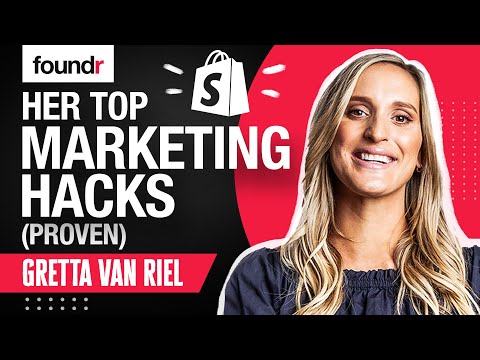
Marketing Plan Template (Copy/Paste)
Marketing Plan Template: [Name of Project]
Marketing Plan Example (Filled Out)
Here’s a fake content marketing plan example for a fictitious shoe company.
Marketing Plan Template: [Project Zeus Running Collection]
Marketing Goal Drive $200,000 in sales for the new Zeus running collection within the first 4 months of launch day.
Target Audience The primary audience is 35 to 50-year-old male recreational runners who tend to run 30-40 miles a week at an average page of 8:00-10:00 minutes per mile. They’re not overly competitive, but they like to race 5K and 10K races occasionally throughout the year and are always trying to beat their personal best. Many have experienced mild injuries over the last few years that the Zeus Running Collection can help alleviate.
Marketing Budget We have a budget of $40,000 for the initial launch period. If we can prove out the Zeus Running Collection, we’ll allocate additional budget after the first 4 months.
- Launch Day: June 1
- Marketing Assets Ready to Go: May 28
- Pre-Launch Teaser: May 24
- Creative Assets Finished: May 21
- Product Beta Tester Reviews Submitted: May 10
- Written Content Creation Period: April 12 – May 7
- Enlist Beta Testers: April 12
- Project Kickoff Meeting: April 5
Marketing Tactics
- Social Media Marketing: Target runners on Instagram and Facebook with paid ads featuring our endorsed runner racing in the shoe.
- Email Marketing: Email existing customers with a 15% off discount code on the new Zeus Running Collection. Email prospects with a link to the product breakdown page with a code for free shipping.
Responsibilities and Assignments
- Lizzy K: Creative assets
- Mark B: Blog post announcement + product page
- Spencer S: Beta tester outreach
- Larry G: Email and social media marketing campaigns
- Carly M: Project manager
Do I need to write a marketing plan for everything?
As stated earlier, marketing plans can come in all shapes and sizes. But that doesn't mean you need one for every single Facebook ad or whitepaper your team creates. The best marketing plans serve as a source of truth for your team to reach a goal. Within the marketing plan, you should have enough wiggle room to adjust your strategy and tactics. Marketing is an art and science, so there are bound to be surprises once you start executing your plan.
How do I know if my marketing plan is a success?
One of the most common mistakes marketers make is creating a seemingly perfect marketing plan and then going off script as soon as there's a sign of trouble or distraction. Using the SMART goal method (specific, measurable, achievable, relevant, and time bound) is a simple way to ensure your marketing plan is applicable. Every marketing plan should be a success, whether you hit your goal or not, because you'll learn something new about your customer, tactics, and business throughout the process.
Who should make a marketing plan?
If you're reading this article, ideally you. A marketing manager or marketing team member typically writes marketing plans, but marketing strategy should start at an enterprise level. The more people understand the marketing plan for your business, the more you can work together (not in silos) to achieve a common goal. You'll see this happen in larger organizations where the marketing team works plan that the product or sales team have no idea about.
Plan It Out—Make It Happen
Every great campaign starts with an even better plan. Don’t leave your startup’s success up to chance—give it all the thought and attention you can.
With the right plan in place, you won’t be crossing your fingers on launch day or during the quarterly review. You’ll be sitting confidently, knowing that everything is running according to plan.
Need a high-level plan for your startup? We got you covered with our free content marketing training .

About Jesse Sumrak
Jesse Sumrak is a writing zealot focused on creating killer content. He’s spent almost a decade writing about startup, marketing, and entrepreneurship topics, having built and sold his own post-apocalyptic fitness bootstrapped business. A writer by day and a peak bagger by night (and early early morning), you can usually find Jesse preparing for the apocalypse on a precipitous peak somewhere in the Rocky Mountains of Colorado.
Related Posts

Create Viral Infographics That Boost Your Organic Traffic

How to Create a Video Sales Letter (Tips and Tricks from a 7-Figure Copywriter)

How to Write a Sales Email That Converts in 2024

What Is a Media Kit: How to Make One in 2024 (With Examples)

Namestorming: How to Choose a Brand Name in 20 Minutes or Less

10 Ways to Increase Brand Awareness without Increasing Your Budget

What Is a Content Creator? A Deep Dive Into This Evolving Industry

Content Creator vs Influencer: What’s the Difference?

How Much Do YouTube Ads Cost? A Beginner’s Pricing Breakdown

How to Get Podcast Sponsors Before Airing an Episode

How Founders Can Overcome Their Sales Fears with AJ Cassata

How to Grow Your YouTube Channel & Gain Subscribers Quickly

How to Write Good Instagram Captions That Hook Your Audience

Discovering the Best CRM for Consultants

10 Instagram Growth Hacks For More Engaged Followers (Without Running Ads)
FREE TRAINING FROM LEGIT FOUNDERS
Actionable Strategies for Starting & Growing Any Business.
Upmetrics AI Assistant: Simplifying Business Planning through AI-Powered Insights. Learn How
Entrepreneurs & Small Business
Accelerators & Incubators
Business Consultants & Advisors
Educators & Business Schools
Students & Scholars
AI Business Plan Generator
Financial Forecasting
AI Assistance
Ai pitch deck generator
Strategic Planning
See How Upmetrics Works →
- Sample Plans
- WHY UPMETRICS?
Customers Success Stories
Business Plan Course
Small Business Tools
Strategic Canvas Templates
E-books, Guides & More
- Sample Business Plans
Marketing Plan For Small Businesses and Entrepreneurs

Chalking Out Your Business Plan
If you are looking to expand or grow your business, the first thing you will need is a marketing plan. Use our marketing plan template, which is created for small businesses, to start writing your marketing plan in no time.
We have created this small business marketing plan template for you to get a good idea of what a perfect marketing plan should look like and what details you will need to include in your winning marketing plan.
Don’t spend another minute overthinking it. Because we can tell you how you can make market assumptions closest to the right one. With the help of a marketing plan. And here, we’ll try to walk you through the entire process of creating a marketing plan for your business.
Small Business Marketing Plan Outline
This is the standard small business marketing plan outline which will cover all important sections that you should include in your business plan .
- Executive Summary
- Target market
- SWOT analysis
- Consumer Analysis
- Competitor profile
- Geographical
- Demographics
- Market research findings
- Customer profile
- Competitor analysis
- Competitor name
- Mission statement
- Sales Objectives
- Profit Objectives
- Pricing Objectives
- Product Objectives
- Pricing strategy
- Product strategy
- Place(Position) strategy
- Promotional strategy
- People strategy (salespeople, staff, etc.)
- Process strategy (Buying experience)
- Physical Environment
- Productivity Strategy
- Marketing Budget
- Risk Assessment
Download a sample marketing business plan
Need help writing your business plan from scratch? Here you go; download our free marketing business plan pdf to start.
It’s a modern business plan template specifically designed for your marketing business. Use the example business plan as a guide for writing your own.
The Quickest Way to turn a Business Idea into a Business Plan
Fill-in-the-blanks and automatic financials make it easy.

Above all, you should work on your marketing plan, but the most essential thing for marketing to work is to go ahead and do it and learn as you go. A plan just helps you avoid simple mistakes and maximize your opportunities.
After getting started with Upmetrics , you can copy this small business marketing plan template into your marketing plan and modify the required information and download your marketing plan pdf and doc file . It’s the fastest and easiest way to start writing your marketing plan.
So, are you ready to start writing your marketing plan?
Related Posts
Digital Marketing Agency Business Plan
Saas Business Plan
How to Craft Business Plan
Top AI Tools for Business Plan Writing
About the Author
Upmetrics Team
Upmetrics is the #1 business planning software that helps entrepreneurs and business owners create investment-ready business plans using AI. We regularly share business planning insights on our blog. Check out the Upmetrics blog for such interesting reads. Read more
Plan your business in the shortest time possible
No Risk – Cancel at Any Time – 15 Day Money Back Guarantee
Popular Templates

Create a great Business Plan with great price.
- 400+ Business plan templates & examples
- AI Assistance & step by step guidance
- 4.8 Star rating on Trustpilot
Streamline your business planning process with Upmetrics .


by Cydney Hatch • March 19, 2020

Marketing Plan Examples & Samples for Business Scaling
Marketing is an essential part of any successful business strategy. It has everything to do with identifying and reaching objectives for your business sales, publicity and growth.
What if, for example, your business was to locate, catalog and find homes for archeological treasures?
Indiana Jones was a master planner in that business space. He conducted extensive research, put together his gear, assembled his teams, and then went out to kick butt and find archeological treasures! Then, afterwards, he improvised and pivoted as needed 😉
The bigger the mission, the more funding, planning and field contacts he used. It makes you think of your marketing plan in a more exciting light, am I right?
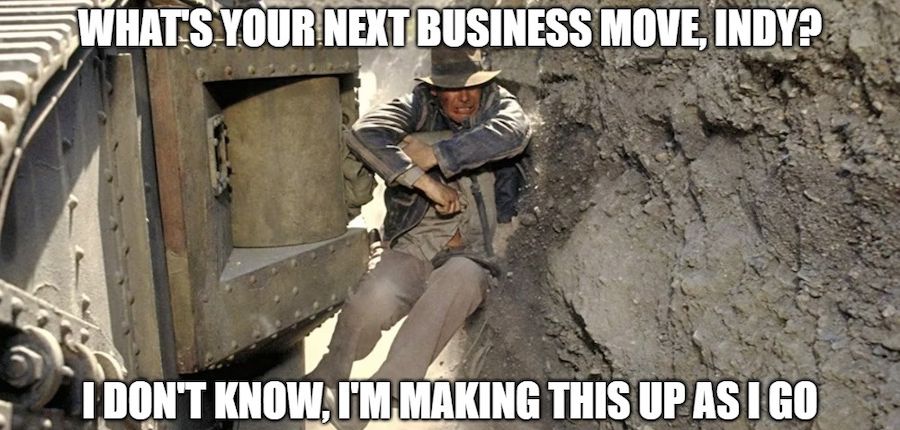
It might seem like a stretch, but just like Indiana Jones, you need to map out your marketing plan so you can try to avoid having to “make it up as you go.” You can see your marketing plan as a comprehensive document that outlines the marketing strategy, tactics, and activities that your business will undertake to achieve its marketing objectives. Also, as your business grows, so too will the strategies, channels and budgets you might need.
There are plenty of examples of marketing plans that you can use as templates for your own, and we will include some of those here.
Remember that a well-crafted marketing plan can help businesses to identify their target audience, determine the best way to reach them, and allocate resources effectively . There might not be one single marketing plan that captures what you want to include, so remember that you can customize any marketing plan to your own business, including what is more important to you.
In this blog post, we will explore what a marketing plan is and provide some examples of marketing plans . I’m also going to walk you through the steps I used to create a made-up business called “Free People Coffee & Bar.” So grab your hat, your whip and your cargo pants for some intense marketing plan discoveries!
MARKETING PLAN EXAMPLES IN ACTION
Before we officially start on what a marketing plan is and how to create one, let’s look at a couple of marketing plan examples that worked well!
MARKETING PLAN EXAMPLE: COCA-COLA “SHARE A COKE” CAMPAIGN
Most of us are aware of the highly popular Coca-Cola “ Share a Coke ” marketing campaign. That is when, in 2014, you started seeing popular names pop up on Coke cans everywhere. The campaign was designed to encourage consumers to buy Coke products to share with friends and family and sparked a social media frenzy as people searched for bottles with their names on them.
What made this campaign work?
- Personalization: By including popular first names on the bottles and cans, Coca-Cola was able to make the product feel more personal and increase consumer engagement.
- Social media: The campaign encouraged people to share pictures of their personalized Coke bottles on social media, creating buzz and driving further engagement.
- Emotional appeal: The campaign’s message of sharing a Coke with loved ones tapped into consumers’ emotions and helped to build a sense of community around the brand.
MARKETING PLAN EXAMPLE: MARRIOTT INFLUENCE MARKETING CAMPAIGN
One great example of a marketing plan that includes utilizing an online influencer is the Marriott “Millionth Mobile Check-In” sweepstakes. For that campaign, Marriott wanted to raise awareness and use of their app for mobile check-ins. They partnered with What’s Trending founder and host, Shira Lazar, and Jeana Smith, founder of Prank vs. Prank , to give the millionth mobile check-in guest a day they would never forget.
To celebrate the millionth customer to check-in to their hotels using the mobile app, Marriott surprised couple, Hunter and Tina Swift, in Los Angeles with balloons, music, and more.
They launched their marketing plan with a sweepstakes to win prizes when you check-in with the app and ended it with this huge event complete with a DJ, bellhop acrobats, dancers, and the gift of one million Marriott Rewards points to the happy couple.

This not only raised brand awareness but drove engagement as visitors were prompted to use the app and enter the sweepstakes. Making it legit by throwing the huge party just made Marriott even cooler.
What made this campaign successful?
- Plan ahead: Marriott knew that it was important to be tracking mobile app check-ins to their hotel chain. This allowed them to know when the millionth check-in was approaching and how to prepare.
- Customer research: They understood their customer base to know how to celebrate the millionth check-in and how to excite other customers to take action in downloading the app to use it for check-ins moving forward.
- Multi-channel messaging: Marriott used different channels to push the video out for the millionth check-in celebration. Doing so created interest on these different channels where they knew they’d get recognition and customer interest.
WHAT IS A MARKETING PLAN & HOW TO MAKE ONE
A marketing plan is a plan of action compiled into organized documents. It takes the essentials of the business and incorporates them into messaging, advertising, outreach, and other initiatives. A marketing campaign cannot be successful without a marketing plan in place.
That means, if you don’t have a marketing plan, you’re basically shooting in the dark. Be the marketer with a plan by starting off with what I’ve crafted. These are the essentials for how to craft a marketing plan.
EXECUTIVE SUMMARY
One of the first parts of a marketing plan is the “Executive Summary.” It may seem a little boring, but it provides clear, compact statements about what each section of your marketing plan will be about. This can be bullet points with descriptions, or a paragraph-style explanation of your plan and what is in it:

PRODUCTS AND SERVICES
Next, you will want to list the many values that you bring to your potential customers—whether it’s products, services or experience. In my marketing plan sample, I wanted to think about how my products and atmosphere helped my potential customers have a different kind of social and dating scene.
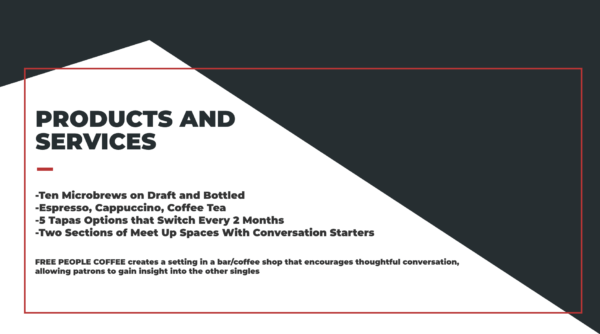
I will be offering quality beverages and small food items as well as social-topic activities that allow people to meet in a different kind of way. This structure made popular from the game, VERTELLIS, will allow our potential customers to have a meaningful conversation with new people. In comparison to other bars, ours will allow singles to have a different type of experience to meet and talk to other singles in a softer-music, nicely-lit, socially-focused place.
VISION AND MISSION STATEMENTS
This is an important place for you to summarize and really hyper-focus what your business will change, do, or offer potential customers.
What is your business value proposition (aka a unique selling proposition – UVP)?
Without a value proposition, there is no reason for people to patronize your business. You should be able to convey in a couple of sentences, what you have to offer and why it is the best.
When you are thinking about your value proposition, be sure to ask yourself whether you have the appropriate infrastructure and resources in place to deliver on your promised value. Pro tip: You should always keep a little space in the back of your mind about how each of these marketing plan pieces will be affected by eventual growth, as well.

In my example, we specifically state our desire/vision to make our community more social. Our vision is to create a place where people can come to have a conversation and a place to facilitate that conversation.
The mission goes further into that statement by answering HOW we will do that. We will create a community bar and coffee shop that potential customers can come and enjoy a different type of bar scene.
No more loud bars, dark rooms and shallow relationship building. FREE PEOPLE allows people to be human, connect and focus on experience supplemented with beverages and food. Like this, you need to think of a vision of WHAT and then move to the mission statement of HOW.

RESEARCH AND ANALYSIS
In this section, you’ll want to report on a variety of market-related things that have an impact on your overall marketing plan. This is the nitty-gritty stuff that can indicate where you stand and offer the exact insights you need in order to market and scale just the right way. The following are part of what you should include:
COMPETITION
Research your competitors and analyze the following:
- Product attributes
- Marketing and promotion strategies
- Distribution channel and method
- Products or services offered
Yes, you’re “spying,” but make no mistake, they are or will be spying on you too.
Take note of what they are doing right–how they are getting in front of their audience, and improve upon those tactics. This will also help you find ways to set yourself apart and create a unique place for yourself in that market space.
In my example marketing plan, FREE PEOPLE, I was able to research some of the hottest bars in the San Francisco area as well as single adult organizations that facilitate meetups.

In your research, look for ways that your competitors keep people coming back for more. For Charlie Chaps, I could see that they are a great stand-up bar that has a lot of hot and funny talent coming in every week. For Bourbon and Branch, it is high-quality drinks at a reasonable price with a fantastic view of the city. You too can find patterns, methods and strategies your competition is doing and shape them to your own business.
Ask yourself the following questions:
- Who are the types of people I want to target?
- What keeps them coming back for more?
- What targeting factors do they have that create interests?
- What are their price points?
- What are their connections?
- How do my competitors advertise to and connect with the community I want to target?
When you have your competition figured out, you can anticipate their moves, improve on their moves, and find a creative edge over them. Staying ahead of his competitors was probably Indiana Jones’s number one concern.
COMPETITIVE ADVANTAGE
So, considering the above competition analysis, my coffee and bar house can offer a place for people to meet in a comfortable, person-meeting environment that young people today want and need. The basic market need is a place where singles can meet new, like-minded people.
FREE PEOPLE uses a conversation system to enhance and facilitate singles meeting each other instead of getting muffled through simple bar scene tactics of dark rooms, loud music and structure not conducive to talking and meeting. We will also offer social community conversations where those who are politically, religiously or personally active can come and have community group discussions with local leaders.
We also offer people products they can take home to promote our social structure outside of our facility. We create question packs that allow buying customers to take this social structure we promote to their homes.
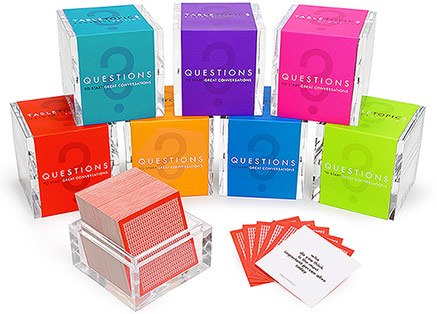
As a community coffee and bar house, it is our job to make our community a better place and to feel more connected. Collectively we offer:
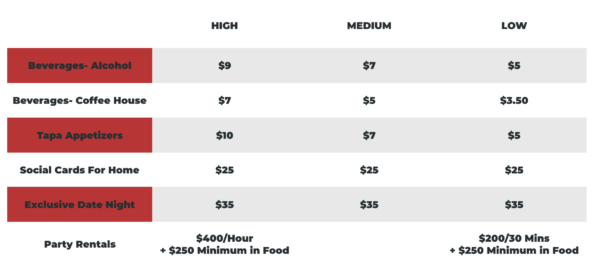
- Food quality: The preference for higher-quality ingredients is being reinforced as consumers have more and more options for food all the time. We keep it simple and always changing to maintain interest. We have also found a price point that is competitive with our competitors.
- Quality conversation: Customers recognize that intellectual conversations can be had in bar settings and would prefer this over normal bar talk. They would also appreciate ways to take this experience home with products they can purchase.
- Access to meeting people: People are tired of being single and are looking for ways to meet like-minded individuals.
By offering not only a place and product but a social change within how we meet others, we can improve the happiness of our potential customers and community. We stand out as a different kind of place where people can be human and connect.
The S.W.O.T. model falls under the research and analysis section of your marketing plan, but it deserves special attention. It stands for: Strengths, Weakness, Opportunities, and Threats. Again, using this acronym in your research and analysis can help you cut out a unique edge and differentiate yourself from your competition. Let’s get into this a little deeper…
When looking at your business strengths you want to list realistic advantages, strengths and positives you bring to the table. When you think about your value proposition this should come easy.
In my marketing plan sample, FREE PEOPLE speaks to the personal and emotional needs young single adults need in their lives: connection and interaction.
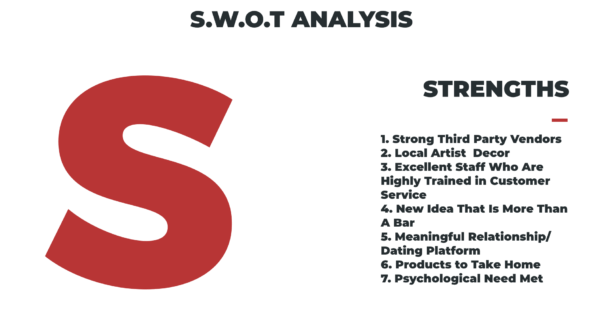
We as a bar and coffee house have strong third-party vendors that give us quality products to make our beverages and appetizers. With great culinary experiences, we have local artists that help us create an aesthetic that promotes creativity, positivity and change. We also have high-quality staff that promotes healthy relationship building and great customer service.
From a business standpoint, we bring new ideas to the bar and social scene that promotes different types of connections that other bars do not. We promote personal conversations, invite meaningful community conversation events with the help of local leaders.
When looking at business weaknesses, consider your competition and what you might lack, compared to them. Don’t be too hard on yourself, but do be honest with yourself. You can’t grow if you can’t see how you need to improve. When you take a look at weaknesses, this also helps you plan out ways to address and improve your business message.
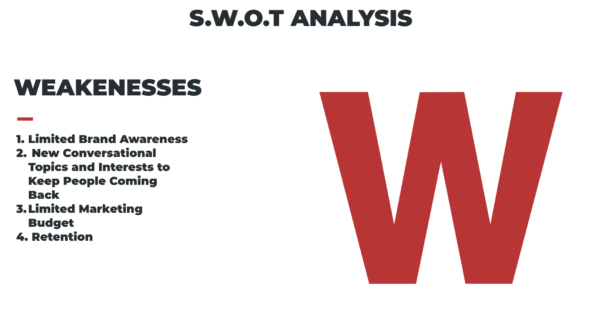
So, in my example, as a new coffee and bar house, we are obviously not as established as some of the known “hot spots” of the city. With that in mind, it also means we do not have as much of an income yet as compared to others for marketing and getting our name out there. This will require us to reach out and try to get influencer endorsement and other free promotions through local news, etc. This will help us draft our content to try and set us up as new, exciting and something to experience.
OPPORTUNITIES
I always love this part of a SWOT analysis because it is all about growth. Here, look for ways you can and will succeed as a business. Look at your market and how it is projected to grow and how that will benefit your business. Look for ways you can undercut and improve what your competition is doing!
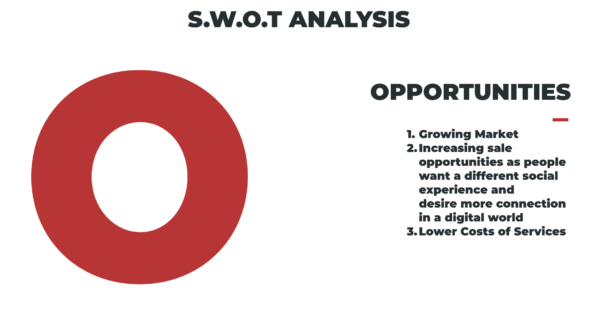
In my example, FREE PEOPLE has a good market to bank on as there are always single people. In fact, San Francisco was named the best city for singles in 2017. With that knowledge, we can monopolize on the sale and other opportunities to reach an ever-growing market of individuals.
If our friend, Indy, didn’t anticipate some threats and difficulties, he wouldn’t be adequately prepared to deal with them. The same is true of everything. Don’t produce a negative effect by dwelling on it or expecting it, but certainly know all that you can about possible threats to your business health. What are the realistic limitations you face? Look for things that will affect your bottom line, limit your target audience, or that will present local problems if not addressed.
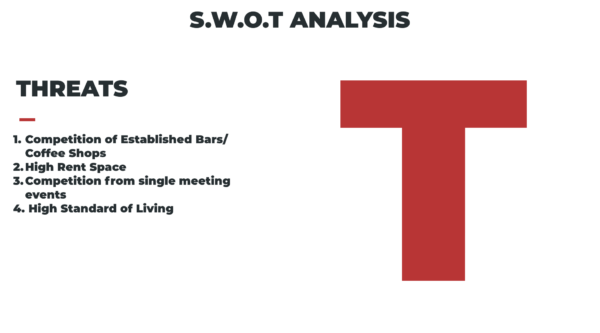
In my sample marketing plan, FREE PEOPLE, has to compete with the existing bars people know and love. It is our job to write content, advertise and communicate with the community about how our bar and coffee shop is a different and better type of experience.
When considering threats other than our competition, we need to look at our target audience. Since we are a bar in one of the most expensive places in the United States, that might put a limitation on the younger end of our demographics to enjoy our services and products. Not to mention, our bottom line is affected because of the expense of operating in that locale.
CUSTOMER INFORMATION: AUDIENCE, PERSONA AND LIFECYCLE
The next major part of your marketing plan is your customer base. Who are you targeting? What are their passions, problems and pain points? What are the different types of customers that are worth your time?
In our example, FREE PEOPLE, we target young single adults ages 25-37, particularly women and socially active adults.

- Young Professional
- San Francisco Bay Area, Apartment/Condo Living
- Income $40,000+
BUYER PERSONA PROFILE INFORMATION
- Values: Human connection, promoting positive social change, education, long-term dating
- Problems: Has a hard time meeting like-minded and similar-aged people, busy work schedules, wants long-term relationships, sick of the same old bar scenes, wants to create positive social change in communities
- Interests: News and current events, socializing, arts and experiences, communication, gym, healthy lifestyle, Instagram and Facebook, traveling, education, dating sites and services, reading, religion and social issues
Once you know your customers you can now look at how best to reach them through meaningful marketing objectives.
WHAT YOU NEED TO DO NEXT
To dive into your marketing strategy, you need to start by knowing what you want to get out of it. Up to this point, you’ve done some research and you know who your competition is, but what do you really want to achieve with this marketing strategy… in essence, what is a marketing plan to you ?
MARKETING OBJECTIVES
Marketing objectives are a brand’s defined goals. They outline the intentions of the marketing team, specific numbers and provide clear actions to execute.
Do not rush or focus on execution before you define what success looks like for your business.
For example, here are a few possible goals you might have:
- Introduce # of new products
- Target a new customer persona
- Extend/regain market
- Build brand awareness
- Develop brand loyalty
- Grow market shares
- Build industry authority
- Boost sales
- Enter into long-term contracts
- Improve delivery and customer service
- Increase brand exposure and engagement on X
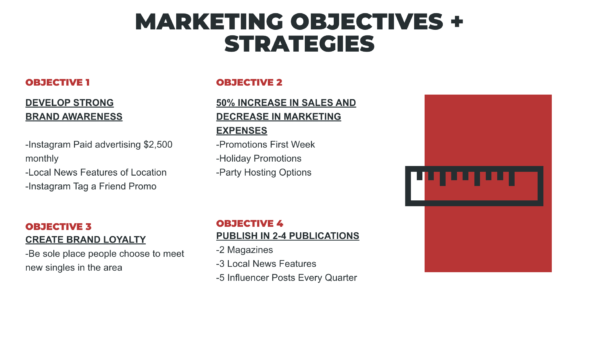
These objectives are fairly broad, but you can get as specific as you need to. As a marketer, it is your job to figure out how to use marketing tactics to achieve these goals! Most plans call for money… so your budget is next up.
CREATE A PROGRESSIVE MARKETING BUDGET
- Focus on what historically worked
- Use tactics that allow full control/customizability
- Don’t scale until you prove ROI
- Cross-channel to double dip
By following proven success tactics and being smart with your marketing budget, you can make money stretch further. Don’t splurge because you want to get things up and running. Plan and patiently execute–you will be grateful you did!
So, for our example with FREE PEOPLE Coffee and Bar, I calculated that the business will need to make at least $40,500 a month in revenue to reach the break-even point.
The first two months will be used to set up the physical location, hire personnel, establish vendor relationships and obtain an alcohol license. The third month will be the grand opening. Business during the second month will be understandably slow as a steady customer base takes time to build. This is the stage where the majority of our marketing budget will go.
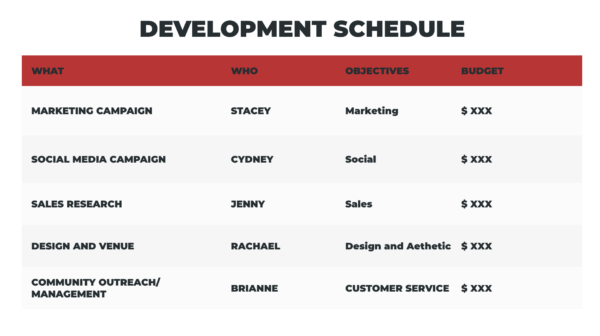
When you create a tentative financial forecast, you will then need to carefully assign people to the detailed marketing campaigns and tasks. With their detailed tasks, be sure to include deadlines, budgets and expectations.
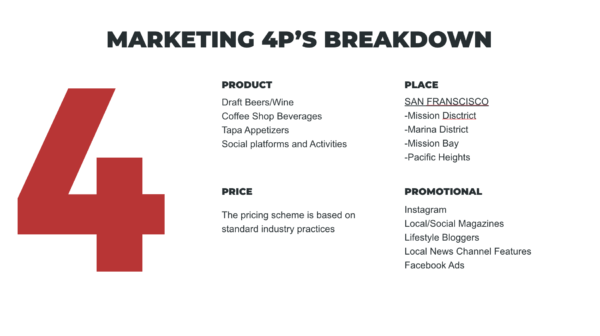
To break things down further, you will want to map out detailed plans for sales funnel content. So, if I was to brainstorm content around my market research and target customers for FREE PEOPLE:
Awareness Stage
- Guides: A Guide to Modern Conversation, Meeting Like Our Parents Did
- Blogs: 11 Ways to Meet Singles in San Francisco, Dating Statistics in the Bay Area, Say Goodbye to Dating Apps and Say Hello to ‘Old School’
Shopping/ Learning Stage
- Video: CONNECT: A FREE PEOPLE EXPERIENCE, Dating Done Right: Meet FREE PEOPLE
- Guides: How Successful Are My Tactics: Statistics on Dating Scene Tactics & Satisfaction
Decision Stage
- Business product comparisons: Advertisement for Promotional Event Night (Change The Way You Meet)
- Blog content: Why We Need to FREE PEOPLE
- Invite to social events: Bring a Friend Night, Community Talk, etc…
- Retention plan: Memberships, Discounts, Birthday Codes
Content not only attracts customers but it also provides SEO value . By creating consistent and quality content, your business blog and website will gain more traffic. Google rewards quality stuff so why not attract some organic marketing help and new customers through Google?!
From there you will also need to consider your social media use, online marketing as well as your collaboration plans with other businesses/influencers.
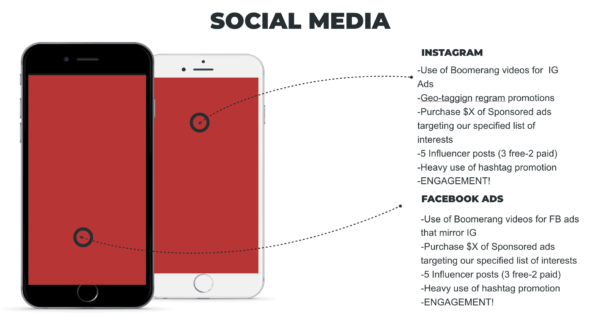
So, in FREE PEOPLE’s example, I wanted to map out specific money amounts we would put towards sponsored ads on Instagram and Facebook.
I also mapped out different types of content and creatives that work for our industry like videos, specifically boomerang. We would also want to make specific hashtags and links people can use so we can start building a network on these platforms.
When looking for influencers we wanted to work with, we would hyper-focus on ones with at least 20k followings and topics that are of interest to us. Specifically Allie.Eats would be a great example of an influencer we would want to pay or invite to experience our new bar as she focuses on bar/food scenes within the San Francisco area.
In return for her promoting our bar, we can give her free products, payment, etc, which promotes a healthy and balanced relationship that can work in the future.

By detailing out these plans, you will be able to track your success and tweak the contracts and campaigns for results in the future. Blogs and backlinks are just a couple of the ways you can make these relationships work for you!
So, for the marketing plan sample of FREE PEOPLE, I made four marketing objectives focused on revenue and exposure. From there, it is my job as the “marketer in charge” to figure out what tactics will help make those objectives happen! I created specific money amounts, platforms and numbers involved to reach the goals we set out as a starting business.
The top priority for FREE PEOPLE’s exposure will be to communicate value to our target audience. This will be done through a variety of methods. The first method will be strategically placed advertisements.
One place that will be used for advertisements is social and local newspapers and magazines. This will be the main source of advertisements because the demographics match up between their audience and ours. We will also do advertisements on Instagram showing users who will partner us as influencers to promote us on that platform. Between paid ads and influencers, we should be able to connect our business with young, single, adult locals.
At a later time, we also want to maximize email marketing for our restaurant/bar . We have to have an agile planning strategy , though, so we can’t get too detailed right now. It’s just something to keep in mind.
Another source of marketing will be through strategic partnerships with companies like gyms that are typically full of single adults. When it came to collaboration with gyms, we were able to offer cross-promotional discounts!
The last exposure marketing tactic we will promote is a grass-roots effort with “bring-a-friend” promotions that invite more people at a reduced cost to experience our business. This tactic will eventually promote brand loyalty as we create an experience people cannot ignore.
SCALED AND MEASURED: YOU CAN ADAPT
Companies are always looking for a new edge to capture mindshare and differentiate their solution within the marketplace. By creating a strong marketing plan you can do that!
Although the above sections are things you should include in your marketing plans, every marketing plan should be fluid and reflect your values and objectives. You will need to customize and scale every plan to your needs but also make it so it’s a living document to adapt to market change.
As you are answering the question, “what is a marketing plan?” for yourself and your company, you will be able to refine your answers until your own marketing plan is ready to launch!
Hopefully, this article and the marketing plan examples in it helped ease your mind and inspire you about how to put your marketing plan together. But if you are still feeling overwhelmed, reach out , we would love to talk!
What do you consider when scaling a marketing plan sample? What are the bigger concerns of templates and using them for different types and sizes of businesses?

Cydney Hatch
Leave a comment, featured posts.

Disruptive Advertising Named One of UV50’s Fastest Growing Companies For the Fifth Year in a Row

How Seth Hymes Turns Broke College Students into Successful Digital Marketers with No Prior Experience

Cost of Instagram Ads in 2022: The Ultimate Guide
- Line of Credit
- How It Works
- Small Business Resources
- Small Business Blog
- Business Stories
- Our Platform
- Lender and Partner Resources
- Our Company
- Example of a Marketing Plan for Small Business
- Learning Center
- Business Marketing
A n effective marketing plan isn’t just another document to file away—it’s a powerful tool that can help you take your business to the next level. This resource can act as your guide for reaching the right customers and using specific strategies to keep them engaged. Plus, the process of creating the plan can help you uncover some opportunity areas, marketing strategies, and competitor insights you might not have considered yet.

How detailed your plan is will depend on your goals and preferences. No matter the number of pages, this guide should serve as a reference to you as you grow your business. More importantly, the process of creating the plan can help you discover your strengths and opportunity areas.
Not sure where to start? Use this checklist of key elements to stay on track:
Market research
A great first step before beginning work on your marketing plan is conducting thorough market research. Start by evaluating the market situation in your specific industry. Identifying competitors, as well as their strengths and weaknesses, can help you understand exactly what you bring to the table and how to use that to your advantage.
You’ll also need to understand your target market. Who is your ideal customer? What are their needs, expectations, and preferences? How does your product or service fit into their routines?
You might have done similar research for your business plan, but as your company evolves, so do your competitors and your target audience. Staying on top of trends in the market can help you prepare to come out on top. Not sure where to start? It’s always a good idea to gather feedback from your customer support and sales teams—through their everyday interactions with customers, they have unique insights into what your prospects are looking for.
Executive summary
The executive summary is usually the first item on your marketing plan, but that doesn’t mean you should write in that order. In just a few sentences, this component should give readers all the major points of the plan and your vision. This means you should have all the other elements of your plan in place before you set out to condense them all into a few words. Creating the summary is a great way to reflect on all your hard work on the bulk of the plan and choose the key concepts you think will have the strongest impact on your business as a whole.
Market overview
If you’ve conducted market research, you’ll probably have plenty of material to add to the overview section. Here, you should present a snapshot of the market as it currently stands and set the framework for your plan. Provide as much detail as possible, including about your own business. For example, how are your products and services performing? Who are your competitors and how are they differentiating themselves in the market? How are your distribution networks and channels performing?
Market analysis
With your overview laid out, it’s time to analyze the trends you’ve demonstrated. What do they mean for your business? If you’ve identified any potential challenges, be specific in your plan of attack. Identified some new opportunities for growth? Outline how you can use them to your advantage and take your business to the next level.
In this section, providing a Strength, Weakness, Opportunity, Threat (SWOT) analysis can help you provide an overview your business’s current state at a glance.
The four Ps of marketing
Using the four Ps of marketing can help you tie the key elements of your marketing plan into a complete picture.
- Product: What is your business selling?
- Place: How is your product being distributed?
- Price: What does your product or service cost your customers?
- Promotion: How is your product or service being publicized?
You can build your marketing plan around any combination of these components. Many small business owners focus on promotion, but even within that category are several strategies you can choose to implement. Will you run paid online advertisements through Google Ads, Facebook, and Linkedin, maintain PR efforts, reach out to customers with direct mail packages, host an event to grow your customer base, or take a different route else entirely?
Marketing goals
Continue to narrow down the scope of your research by breaking down the overall trends, opportunity areas, and challenges into specific marketing objectives. As you think about your business in terms of its long-term growth, use these goals to help you carry out your plan and understand not only how, but why it’ll work.
Looking for examples of marketing objectives? Here are some common options:
- Reach a new customer base by expanding into more areas
- Leverage an upcoming product launch to reach more potential customers
- Expand marketing efforts in a specific channel to boost sales

Marketing strategy
Here’s where you can answer specifically how you’ll achieve your marketing goals. This section is all about defining your plan of action when it comes to execution.
You’ll also want to define and measure the success of your marketing efforts. Based on your research about your ideal customer, tailor your strategy so you can focus on being the most effective when it comes to reaching them. Then, make sure you have a way to judge whether your marketing campaigns are performing and an action plan for making adjustments based on those results.
Implementation
Getting into the nitty gritty, the implementation section helps you define your strategies more narrowly and get a sense of exactly how you’ll carry them out. Here’s where you can break your plan down into actionable milestones and detail the steps it’ll take to get there. Think of this section as a roadmap—what can you tackle this month, this quarter, or this year? As you lay out the steps, consider how you’ll divide up the responsibility as well.
Even if your target campaigns seem far away, being as specific as possible can help you gauge how realistic they actually are.
This important section outlines both the expected costs and benefits of your marketing strategies. At this point, you’ll primarily be working with estimates and assumptions so do your research and consult with a trusted financial advisor, if possible, to help avoid surprises down the line. Don’t forget to add up all the possible costs, whether that be the required spend for a social media advertisement or a potential new hire to help distribute the workload.
Needs and requirements
What will you need to be most successful in carrying out your marketing plan? This is your opportunity to specify the resources you’ll need, as well as how you’ll find them and use them. For example, do you need some basic business marketing materials before you can get started? Can you take your productivity to the next level with an easy-to-use software solution ? Do you need a stronger system in place for managing your small business finances and making more informed budgeting decisions? Can you look to hire help when it comes to implementing a specific strategy?
Use this section not only to list your needs, but to explain the reasoning behind your minimum requirements. It can help to divide the checklist into sections based on priority—for example, must haves now, must haves later, and nice to haves.
Evaluation and measurement
The final, and arguably most important, part of your marketing plan includes a detailed strategy for monitoring your progress. You should decide on the metrics you’ll use to measure success at the outset, because they’ll help you keep your finger on the pulse of your campaigns and make adjustments on the fly. Some baseline measures to include are Return on Investment (ROI) to understand whether you’re on track financially.
Keep in mind that this will probably take careful planning because some strategies don’t lead directly into sales. For example, your content marketing strategy might drive more potential customers to your website, but the substantial ROI comes when it’s paired with email or social media campaigns to keep those users coming back.
Revenue isn’t the only metric you should be using to gauge your strategies’ success. Other options might include brand awareness, engagement, customer loyalty , or perceived reputation, to name a few. Translating these abstract concepts into concrete data points can take some creativity, so take your time and make sure they’re useful. After all, intuition can only go so far. These numbers should help you ground your decisions in solid data.
Once you’ve decided on the measures you’ll use, configure reports you can check on daily and schedule time on your calendar regularly to go over results in more detail.
Looking for more helpful tips, advice, and recommendations for small business experts? Visit the SmartBiz Resource Center and search for “Business Marketing” to keep reading.
Download our free Small Business Saturday Resource Guide to access exclusive strategies for success, marketing materials, and articles to help you prepare for the nationwide promotion running this holiday season.

Have 5 minutes? Apply online

- Follow SmartBiz
Access to the right loan for right now

- Business Credit
- Business Finances
- Business Owners
- Business Technologies
- Emergency Resources
- Employee Management
- Small Business Loans
- SmartBiz University
- More SBA Articles
Related Posts
Smartbiz helps facilitate access to financing for underrepresented entrepreneurs, women-owned business certification: learn about how to get yours, bank term loans 101: understanding the basics for small business, smart growth is smart business.
See if you pre-qualify, without impacting your credit score. 1
*We conduct a soft credit pull that will not affect your credit score. However, in processing your loan application, the lenders with whom we work will request your full credit report from one or more consumer reporting agencies, which is considered a hard credit pull and happens after your application is in the funding process and matched with a lender who is likely to fund your loan.
The SmartBiz® Small Business Blog and other related communications from SmartBiz Loans® are intended to provide general information on relevant topics for managing small businesses. Be aware that this is not a comprehensive analysis of the subject matter covered and is not intended to provide specific recommendations to you or your business with respect to the matters addressed. Please consult legal and financial processionals for further information.

Marketing Plan for Small Business

A well-organized marketing plan is one of the important requirements that businesses should meet. It is amazing how much a marketing plan can contribute to a business’s success, may it be a big or small one. This isn’t to scare you, but designing a marketing plan will never be easy work; it demands a lot of research, time, and even money, but the process will surely be worth every struggle. Thankfully, we can help lessen your trouble with the following marketing plan examples and templates specifically designed for small businesses. Download them now to start improving your enterprise!
[bb_toc content=”][/bb_toc]
Marketing Plan for Small Business Examples and Templates
Simple marketing plan template for small business.
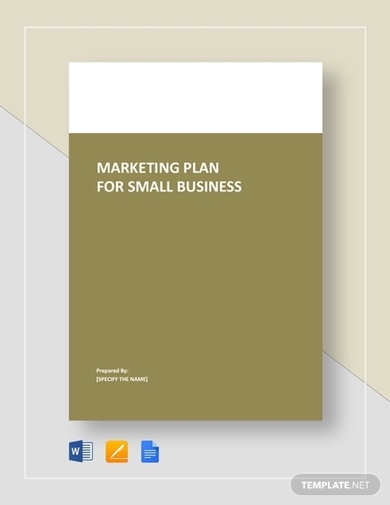
- Google Docs
Size: A4, US
Understanding the different factors that may affect your business is just one of the steps necessary for business growth. But how do you understand or even recognize those factors? The answer: business and marketing plans. Fortunately, we can provide you with a marketing plan template customized for small businesses! It’s all written down for you; all you need to do is to substitute the yellow highlights according to your own needs. Download it now to start the process.
Quarterly Marketing Plan Template
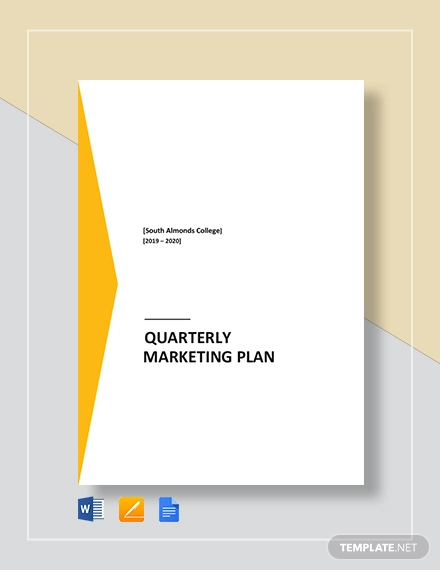
Marketing Plan for Auto Repair Shops

Size: 118.1 KB
Yes, even auto repair shops need to outline their marketing strategies and implement them effectively. Since a lot of people have been purchasing cars, it just follows that these people will also need more auto repair shops. Just because an auto repair shop is a relatively small business does not mean that it shouldn’t be threatened by its arising competitors. If you are planning to open your own auto repair shop, you can refer to this marketing plan sample from J&K Auto Repair; their plan only comprises of three pages but it sure does cover everything that an auto repair shop owner needs to know.
Bakery Marketing Plan
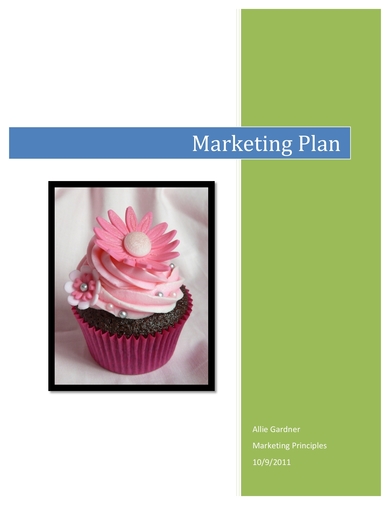
Size: 217.6 KB
In almost every corner of the street, bakery stands are giving off delicious and aromatic heat. However, a bakery’s inviting ambiance and smell is only one part of their marketing strategies. If you are thinking of starting your own small bakery, consider this marketing plan sample from Cup of Cake Cafe. This marketing plan was created before the bakery/cafe opened and thus will be greatly useful to those who wish to launch their own bakery. It is fairly simple and understandable especially for those who are new to the small business industry. Download it now and start the sugary journey!
Marketing Plan for Small Marketing Company

Size: 197.2 KB
Company transition is something that every corporate stakeholder must prepare for, and one of the things that must be at the ready is a competent marketing plan . Like the sample above, Star Software, Inc. has transitioned from a printing company to an all-out advertising/marketing company. With that, they just gained more pressure to effectively market their products and services since they now belong in the advertising industry. And they handled that pressure well enough through their comprehensive marketing plan.
Bicycle Shops Marketing Plan
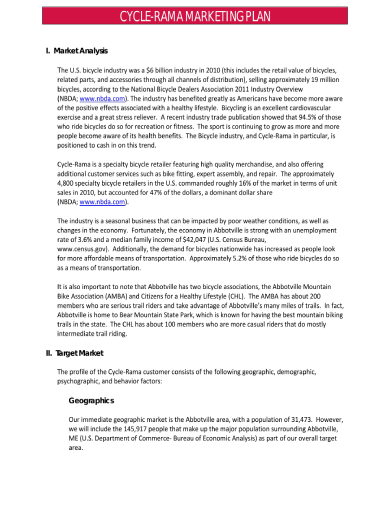
Size: 158.7 KB
Like auto repair shops, bicycle shops also need to assemble their own marketing plan. Many people may have bought cars but the number of people who have turned to bicycles have also increased; they believe that it is better to ride such two-wheeled vehicles since it has physical benefits and does not contribute to environmental pollution. In fact, if you want to start your own line of bicycle shops, you can use that knowledge as one of your marketing strategies, and you might also want to refer to the above marketing plan from Cycle-Rama.
Detailed Marketing Plan for Bakery
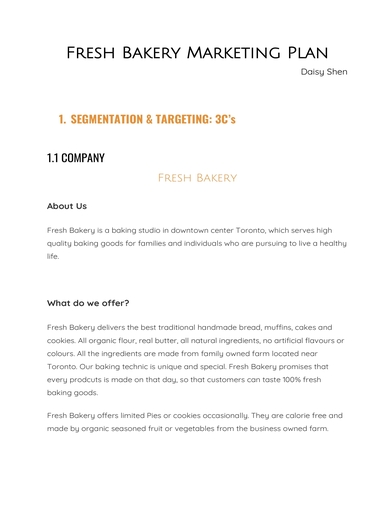
Size: 1.4 MB
This sample bakery marketing plan is quite different from the one we have provided above. The previous marketing plan was designed for a bakery that was yet to open while this one was made for an existing small bakery. Additionally, this marketing plan is much more contemporary and detailed than the previous one. It effectively outlines their customer personas, competitor’s strengths and weaknesses, and their own bakery’s strong points. This is significantly useful for those bakery owners who wish to flourish more in the baking industry despite having reputable competitors.
In-depth Marketing Plan for Small Bookshops

Size: 1.2 MB
With the rise of electronic books, physical textbooks are now facing a considerable amount of danger along with bookshop owners and printing companies. That is why bookshop owners and all those affected with the unfavorable effects of this technological advancement must write their own marketing plans to avoid completely getting caught with the downfall. As a bookshop owner, you could market all the points as to how a physical book is much better than the ones found online; but just to have more guidance, download and make use of this sample marketing plan specifically designed for small bookshops.
Marketing Plan for Room Cleaning Services
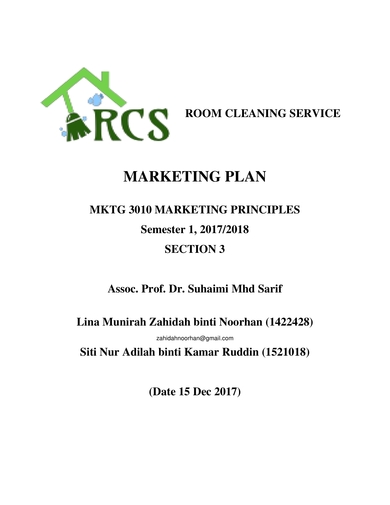
Size: 448.4 KB
Room cleaning services can exist outside of the hospitality industry. In this sample marketing plan above, room cleaning services are being provided mostly for students since the service provider has found that the students might be having difficulties in maintaining room cleanliness. Moreover, the marketer has clearly and directly outlined their marketing strategies as well as the services they have given ever since they started their business. It is also a unique marketing plan since it features an Islamic paradigm, which has immensely influenced the business.
Car Wash Business Marketing Plan and Strategies

Size: 775.8 KB
More cars, more auto repair shops, more car wash service providers. If you’re planning to launch your own car wash business, you must download and make use of this universal marketing plan that gives heavy emphasis on car wash marketing strategies. It does not contain all the technical terms that you typically see in a marketing plan, but it sure can positively affect your car wash business if you take note of the various marketing strategies applicable to this type of business. Download this sample now for free.
Marketing Plan for Fitness Centers

Size: 1.9 MB
You might think it’s easy to market the services and products of fitness/wellness centers , but no, it still requires lots of effort. In this 71-page marketing plan from Huga Sport, you can really see how rigorous the process is when it comes to making marketing plans. The sample includes external and internal analysis as well as their marketing strategies. Huga Sport really invested a great deal of time and money on this marketing plan, but they also made sure that it will remain relevant even when changes in the business industry will come.
Elaborate Marketing Plan for Hair Care Products
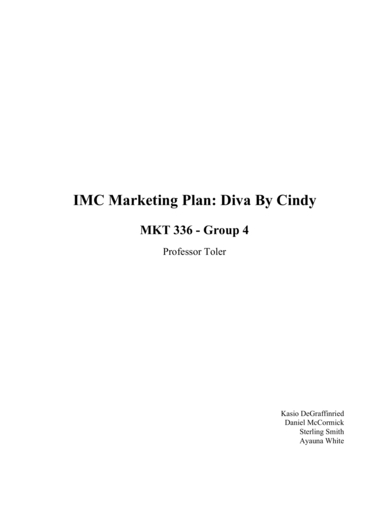
Size: 503 KB
As a marketer and hair care business owner, you must never rely on the fact that women really love to spend money on their hair. Competitions and improvements in the industry will always pose threats to your line of business. That is, unless you adapt a highly effective marketing plan. Above is Diva by Cindy’s extremely elaborate marketing plan that you can refer to if you wish to promote your own products. They have their own kind of analysis, which they have termed the Promotion Opportunity Analysis, which is very helpful if you wish to recognize and understand the different promotion opportunities for your products.
One-Page Marketing Plan

Size: 26.4 KB
Sometimes, your marketing plan just has to be short and simple. Well, that entirely depends on the scope and needs of your business. So if you own just a simple, small business that doesn’t really require vast marketing efforts, try referring to this one-page sample marketing plan above. It speaks in a generalized manner which is very much applicable to smaller businesses. Download it now for free!
Text prompt
- Instructive
- Professional
Create a study plan for final exams in high school
Develop a project timeline for a middle school science fair.
- Starting a Business
- Growing a Business
- Small Business Guide
- Business News
- Science & Technology
- Money & Finance
- For Subscribers
- Write for Entrepreneur
- Entrepreneur Store
- United States
- Asia Pacific
- Middle East
- South Africa
Copyright © 2024 Entrepreneur Media, LLC All rights reserved. Entrepreneur® and its related marks are registered trademarks of Entrepreneur Media LLC
6 Marketing Lessons Small Businesses Can Learn From the Big Players Here are six major takeaways you can apply to your next product launch.
By Joseph Camberato • Apr 5, 2024
Key Takeaways
- Leverage social media effectively to push your brand or product into the public eye.
- Create mutually beneficial partnerships to amplify excitement around your product and reach broader audiences.
- Maintain brand consistency to help customers recognize and connect with your products or services.
- Incorporate user-generated content to create a buzz around your product launch and give your audience a sense of ownership around it.
- Understand your audience, and start your marketing early to create awareness and test strategies.
Opinions expressed by Entrepreneur contributors are their own.
Going to the movies doesn't generate the same excitement it used to. The price of tickets and popcorn are higher than ever, and you don't have to wait long for your favorite movies to be streaming on Amazon.
But in 2023, Barbie made people excited to go to the movies again. The film brought in $1.45 billion worldwide , making it the highest-grossing film of the year. While Barbie's success is due to the directing and quality of the film, it's hard to overlook the film's excellent marketing strategy.
As a small business owner, you can learn valuable marketing lessons by studying major marketing campaigns like Barbie and, more recently, Dune: Part 2 . Let's look at six major takeaways you can apply to your next product launch.
Related: 'Barbie' Was a Marketing Masterpiece. Here's Why.
1. Incorporate social media
A large part of Barbie 's success is due to its social media campaign — the movie was heavily promoted on Instagram, Facebook, TikTok and Twitter. You could find behind-the-scenes content, trailers, memes and interactive posts.
There were promotional hashtags, like #BarbieMovieMagic, which encouraged fans to create and share user-generated content. The Barbie team also partnered with celebrities and influencers who shared their experiences and thoughts about the movie.
The Barbie movie is an example of what can happen when you leverage social media to its fullest extent. When used effectively, it can create unstoppable momentum that pushes a brand or product into the public eye.
2. Collaborate with other brands
The Barbie marketing campaign focused on collaborating with other brands to promote the movie. In total, Mattel partnered with over 100 brands — for example, Forever 21 created Barbie-inspired clothing like crop tops, mesh tees and hoodies.
Airbnb listed the iconic Malibu DreamHouse on its site. Restaurant chains like McDonald's, Burger King and Cold Stone also partnered with Barbie to promote the movie. Cold Stone's pink cotton candy ice cream shake even went viral on TikTok .
It's hard to market a product on your own, and Barbie demonstrates what can happen when you create mutually beneficial partnerships on a very large scale. The right partnerships can generate more excitement among your audience and put your brand in front of entirely new audiences.
Related: 5 Ways to Effectively Utilize Marketing Collaborations
3. Create brand consistency
When you think of Barbie , there's probably one thing that comes to mind — the color pink. Barbie pink became a central part of the movie. The color was not only used throughout the movie but also incorporated in all of the promotional materials and campaigns.
Even blank billboards with nothing more than the color pink and the date of the film's release were instantly recognized as promoting the film. Once the movie was released, people began flooding the theatres dressed in their best Barbie pink outfits.
Brand consistency matters because it helps customers create an emotional connection to your products. When customers immediately recognize your brand, it creates familiarity and a greater sense of trust.
4. Encourage user-generated content
User-generated content may not be applicable to every marketing campaign, but if you can use it, it's an effective tool. User-generated content was pivotal to marketing Barbie, and fans were constantly encouraged to engage with the movie.
There was a Barbie selfie generator that allowed fans to edit themselves into the movie poster. And there was tons of user-generated content posted on social media. User-generated content can not only create a buzz around a product launch but also give your audience a sense of ownership around it.
Related: The Beginner's Guide to User-Generated Content
5. Start early
Most people probably became aware of the Barbie movie last spring or summer during the months leading up to its release. However, the marketing team spent years planning its launch and setting up partnerships.
In fact, the first marketing materials debuted in 2022 at CinemaCon with a photo of Barbie in her pink convertible. By starting early , the marketing team could be selective about its partnership and narrow in on the best strategies.
Effective marketing campaigns don't open overnight — the earlier you begin marketing a product launch, the more time you have to create awareness. Plus, marketing early and often gives you a chance to test out different strategies and see what works.
6. Know your audience
One of the biggest things the Barbie marketing campaign demonstrates is a deep understanding of its audience . The Barbie brand has been around since 1959, and the movie embraced the power of nostalgia to appeal to older fans who grew up with the dolls.
At the same time, the movie's focus on diversity and inclusion made it relevant to younger generations. The movie succeeded by giving fans what they really wanted — an experience that resonated with people of all ages.
When you know your audience, you can create relevant, targeted content you know they'll identify with. It also helps you create a relationship with your audience and create long-term customer loyalty .
Entrepreneur Leadership Network® Contributor
CEO of National Business Capital
Want to be an Entrepreneur Leadership Network contributor? Apply now to join.
Editor's Pick Red Arrow
- A Student in an Ivy League University's Most Popular MBA Leadership Class Asked a Tough Question: What If Your Boss's Downfall Is Necessary to Get Ahead?
- Lock Zillow Co-Founder Shares a 'Misunderstood' Truth About Starting, Funding and Selling Your Company
- Lisa Vanderpump Says If You Want to Run a Business, Get Some Thicker Skin
- Lock These Are the 10 Best States for Starting a Side Hustle , New Research Reveals
- Popular Appetite Suppressant Ozempic Can Be Made for Less Than $5 a Month , New Research Suggests
- Lock Bankruptcy Isn't a Sign of Failure — It's a Strategy. Here's Why It Might Be the Right Move for You .
Most Popular Red Arrow
Barbara corcoran says if you want to become a millionaire do this 1 thing: 'i out-try anyone'.
Practice makes perfect.
Expand International Communication with Lifetime Access to Rosetta Stone Language Learning
This proven and popular platform has helped millions of users learn new languages.
I've Had a Secret Side Hustle for Decades. It Keeps Tens of Thousands of Dollars in My Pocket — and Gets Me Into Places I Wouldn't Go Otherwise.
When Cliff Smith lost his job, he picked up an under-the-radar gig that would make it possible to keep dining out — something he and his wife love to do.
You Need a Community With Shared Values to Find Long-Term Success — Here's How to Cultivate It.
Entrepreneurs need to remember this growth strategy: nurturing a purpose-driven community of like-minded entrepreneurs around them.
Pick Either a $40 or $70 Membership and Save on a Lifetime of Flights
There's really nothing easier than letting someone else find you bargains on all your future air fare and sending them to your phone or email.
Google Is Reportedly Considering a Subscription Fee for AI-Enhanced Internet Searches
We had access to the core Google AI search experience, which is currently being tried in beta for select users. Here's what we found.
Successfully copied link
24 of My Favorite Sample Business Plans & Examples For Your Inspiration
Published: February 06, 2024
I believe that reading sample business plans is essential when writing your own.

hbspt.cta._relativeUrls=true;hbspt.cta.load(53, 'e9d2eacb-6b01-423a-bf7a-19d42ba77eaa', {"useNewLoader":"true","region":"na1"});
As you explore business plan examples from real companies and brands, it’s easier for you to learn how to write a good one.
But what does a good business plan look like? And how do you write one that’s both viable and convincing. I’ll walk you through the ideal business plan format along with some examples to help you get started.
Table of Contents
Business Plan Format
Business plan types, sample business plan templates, top business plan examples.
Ask any successful sports coach how they win so many games, and they’ll tell you they have a unique plan for every single game. To me, the same logic applies to business.
If you want to build a thriving company that can pull ahead of the competition, you need to prepare for battle before breaking into a market.
Business plans guide you along the rocky journey of growing a company. And if your business plan is compelling enough, it can also convince investors to give you funding.
With so much at stake, I’m sure you’re wondering where to begin.
.webp)
Free Business Plan Template
The essential document for starting a business -- custom built for your needs.
- Outline your idea.
- Pitch to investors.
- Secure funding.
- Get to work!
You're all set!
Click this link to access this resource at any time.
Fill out the form to get your free template.
First, you’ll want to nail down your formatting. Most business plans include the following sections.
1. Executive Summary
I’d say the executive summary is the most important section of the entire business plan.
Why? Essentially, it's the overview or introduction, written in a way to grab readers' attention and guide them through the rest of the business plan. This is important, because a business plan can be dozens or hundreds of pages long.
There are two main elements I’d recommend including in your executive summary:
Company Description
This is the perfect space to highlight your company’s mission statement and goals, a brief overview of your history and leadership, and your top accomplishments as a business.
Tell potential investors who you are and why what you do matters. Naturally, they’re going to want to know who they’re getting into business with up front, and this is a great opportunity to showcase your impact.
Need some extra help firming up those business goals? Check out HubSpot Academy’s free course to help you set goals that matter — I’d highly recommend it
Products and Services
To piggyback off of the company description, be sure to incorporate an overview of your offerings. This doesn’t have to be extensive — just another chance to introduce your industry and overall purpose as a business.
In addition to the items above, I recommend including some information about your financial projections and competitive advantage here too.:
Keep in mind you'll cover many of these topics in more detail later on in the business plan. So, keep the executive summary clear and brief, and only include the most important takeaways.
Executive Summary Business Plan Examples
This example was created with HubSpot’s business plan template:

This executive summary is so good to me because it tells potential investors a short story while still covering all of the most important details.
.webp?width=500&height=418&name=executive-summary-business-plans-examples%20(1).webp)
Image Source
Tips for Writing Your Executive Summary
- Start with a strong introduction of your company, showcase your mission and impact, and outline the products and services you provide.
- Clearly define a problem, and explain how your product solves that problem, and show why the market needs your business.
- Be sure to highlight your value proposition, market opportunity, and growth potential.
- Keep it concise and support ideas with data.
- Customize your summary to your audience. For example, emphasize finances and return on investment for venture capitalists.
Check out our tips for writing an effective executive summary for more guidance.
2. Market Opportunity
This is where you'll detail the opportunity in the market.
The main question I’d ask myself here is this: Where is the gap in the current industry, and how will my product fill that gap?
More specifically, here’s what I’d include in this section:
- The size of the market
- Current or potential market share
- Trends in the industry and consumer behavior
- Where the gap is
- What caused the gap
- How you intend to fill it
To get a thorough understanding of the market opportunity, you'll want to conduct a TAM, SAM, and SOM analysis and perform market research on your industry.
You may also benefit from creating a SWOT analysis to get some of the insights for this section.
Market Opportunity Business Plan Example
I like this example because it uses critical data to underline the size of the potential market and what part of that market this service hopes to capture.

Tips for Writing Your Market Opportunity Section
- Focus on demand and potential for growth.
- Use market research, surveys, and industry trend data to support your market forecast and projections.
- Add a review of regulation shifts, tech advances, and consumer behavior changes.
- Refer to reliable sources.
- Showcase how your business can make the most of this opportunity.
3. Competitive Landscape
Since we’re already speaking of market share, you'll also need to create a section that shares details on who the top competitors are.
After all, your customers likely have more than one brand to choose from, and you'll want to understand exactly why they might choose one over another.
My favorite part of performing a competitive analysis is that it can help you uncover:
- Industry trends that other brands may not be utilizing
- Strengths in your competition that may be obstacles to handle
- Weaknesses in your competition that may help you develop selling points
- The unique proposition you bring to the market that may resonate with customers
Competitive Landscape Business Plan Example
I like how the competitive landscape section of this business plan below shows a clear outline of who the top competitors are.
.webp?width=500&height=405&name=competitive-landscape-business-plans-examples%20(1).webp)
It also highlights specific industry knowledge and the importance of location, which shows useful experience in this specific industry.
This can help build trust in your ability to execute your business plan.
Tips for Writing Your Competitive Landscape
- Complete in-depth research, then emphasize your most important findings.
- Compare your unique selling proposition (USP) to your direct and indirect competitors.
- Show a clear and realistic plan for product and brand differentiation.
- Look for specific advantages and barriers in the competitive landscape. Then, highlight how that information could impact your business.
- Outline growth opportunities from a competitive perspective.
- Add customer feedback and insights to support your competitive analysis.
4. Target Audience
Use this section to describe who your customer segments are in detail. What is the demographic and psychographic information of your audience?
If your immediate answer is "everyone," you'll need to dig deeper. Here are some questions I’d ask myself here:
- What demographics will most likely need/buy your product or service?
- What are the psychographics of this audience? (Desires, triggering events, etc.)
- Why are your offerings valuable to them?
I’d also recommend building a buyer persona to get in the mindset of your ideal customers and be clear on why you're targeting them.
Target Audience Business Plan Example
I like the example below because it uses in-depth research to draw conclusions about audience priorities. It also analyzes how to create the right content for this audience.

Tips for Writing Your Target Audience Section
- Include details on the size and growth potential of your target audience.
- Figure out and refine the pain points for your target audience , then show why your product is a useful solution.
- Describe your targeted customer acquisition strategy in detail.
- Share anticipated challenges your business may face in acquiring customers and how you plan to address them.
- Add case studies, testimonials, and other data to support your target audience ideas.
- Remember to consider niche audiences and segments of your target audience in your business plan.
5. Marketing Strategy
Here, you'll discuss how you'll acquire new customers with your marketing strategy. I’d suggest including information:
- Your brand positioning vision and how you'll cultivate it
- The goal targets you aim to achieve
- The metrics you'll use to measure success
- The channels and distribution tactics you'll use
I think it’s helpful to have a marketing plan built out in advance to make this part of your business plan easier.
Marketing Strategy Business Plan Example
This business plan example includes the marketing strategy for the town of Gawler.
In my opinion, it really works because it offers a comprehensive picture of how they plan to use digital marketing to promote the community.

Tips for Writing Your Marketing Strategy
- Include a section about how you believe your brand vision will appeal to customers.
- Add the budget and resources you'll need to put your plan in place.
- Outline strategies for specific marketing segments.
- Connect strategies to earlier sections like target audience and competitive analysis.
- Review how your marketing strategy will scale with the growth of your business.
- Cover a range of channels and tactics to highlight your ability to adapt your plan in the face of change.
6. Key Features and Benefits
At some point in your business plan, you'll need to review the key features and benefits of your products and/or services.
Laying these out can give readers an idea of how you're positioning yourself in the market and the messaging you're likely to use. It can even help them gain better insight into your business model.
Key Features and Benefits Business Plan Example
In my opinion, the example below does a great job outlining products and services for this business, along with why these qualities will attract the audience.

Tips for Writing Your Key Features and Benefits
- Emphasize why and how your product or service offers value to customers.
- Use metrics and testimonials to support the ideas in this section.
- Talk about how your products and services have the potential to scale.
- Think about including a product roadmap.
- Focus on customer needs, and how the features and benefits you are sharing meet those needs.
- Offer proof of concept for your ideas, like case studies or pilot program feedback.
- Proofread this section carefully, and remove any jargon or complex language.
7. Pricing and Revenue
This is where you'll discuss your cost structure and various revenue streams. Your pricing strategy must be solid enough to turn a profit while staying competitive in the industry.
For this reason, here’s what I’d might outline in this section:
- The specific pricing breakdowns per product or service
- Why your pricing is higher or lower than your competition's
- (If higher) Why customers would be willing to pay more
- (If lower) How you're able to offer your products or services at a lower cost
- When you expect to break even, what margins do you expect, etc?
Pricing and Revenue Business Plan Example
I like how this business plan example begins with an overview of the business revenue model, then shows proposed pricing for key products.

Tips for Writing Your Pricing and Revenue Section
- Get specific about your pricing strategy. Specifically, how you connect that strategy to customer needs and product value.
- If you are asking a premium price, share unique features or innovations that justify that price point.
- Show how you plan to communicate pricing to customers.
- Create an overview of every revenue stream for your business and how each stream adds to your business model as a whole.
- Share plans to develop new revenue streams in the future.
- Show how and whether pricing will vary by customer segment and how pricing aligns with marketing strategies.
- Restate your value proposition and explain how it aligns with your revenue model.
8. Financials
To me, this section is particularly informative for investors and leadership teams to figure out funding strategies, investment opportunities, and more.
According to Forbes , you'll want to include three main things:
- Profit/Loss Statement - This answers the question of whether your business is currently profitable.
- Cash Flow Statement - This details exactly how much cash is incoming and outgoing to give insight into how much cash a business has on hand.
- Balance Sheet - This outlines assets, liabilities, and equity, which gives insight into how much a business is worth.
While some business plans might include more or less information, these are the key details I’d include in this section.
Financials Business Plan Example
This balance sheet is a great example of level of detail you’ll need to include in the financials section of your business plan.

Tips for Writing Your Financials Section
- Growth potential is important in this section too. Using your data, create a forecast of financial performance in the next three to five years.
- Include any data that supports your projections to assure investors of the credibility of your proposal.
- Add a break-even analysis to show that your business plan is financially practical. This information can also help you pivot quickly as your business grows.
- Consider adding a section that reviews potential risks and how sensitive your plan is to changes in the market.
- Triple-check all financial information in your plan for accuracy.
- Show how any proposed funding needs align with your plans for growth.
As you create your business plan, keep in mind that each of these sections will be formatted differently. Some may be in paragraph format, while others could be charts or graphs.
The formats above apply to most types of business plans. That said, the format and structure of your plan will vary by your goals for that plan.
So, I’ve added a quick review of different business plan types. For a more detailed overview, check out this post .
1. Startups
Startup business plans are for proposing new business ideas.
If you’re planning to start a small business, preparing a business plan is crucial. The plan should include all the major factors of your business.
You can check out this guide for more detailed business plan inspiration .
2. Feasibility Studies
Feasibility business plans focus on that business's product or service. Feasibility plans are sometimes added to startup business plans. They can also be a new business plan for an already thriving organization.
3. Internal Use
You can use internal business plans to share goals, strategies, or performance updates with stakeholders. In my opinion, internal business plans are useful for alignment and building support for ambitious goals.
4. Strategic Initiatives
Another business plan that's often for sharing internally is a strategic business plan. This plan covers long-term business objectives that might not have been included in the startup business plan.
5. Business Acquisition or Repositioning
When a business is moving forward with an acquisition or repositioning, it may need extra structure and support. These types of business plans expand on a company's acquisition or repositioning strategy.
Growth sometimes just happens as a business continues operations. But more often, a business needs to create a structure with specific targets to meet set goals for expansion. This business plan type can help a business focus on short-term growth goals and align resources with those goals.
Now that you know what's included and how to format a business plan, let's review some of my favorite templates.
1. HubSpot's One-Page Business Plan
Download a free, editable one-page business plan template..
The business plan linked above was created here at HubSpot and is perfect for businesses of any size — no matter how many strategies we still have to develop.
Fields such as Company Description, Required Funding, and Implementation Timeline give this one-page business plan a framework for how to build your brand and what tasks to keep track of as you grow.
Then, as the business matures, you can expand on your original business plan with a new iteration of the above document.
Why I Like It
This one-page business plan is a fantastic choice for the new business owner who doesn’t have the time or resources to draft a full-blown business plan. It includes all the essential sections in an accessible, bullet-point-friendly format. That way, you can get the broad strokes down before honing in on the details.
2. HubSpot's Downloadable Business Plan Template

We also created a business plan template for entrepreneurs.
The template is designed as a guide and checklist for starting your own business. You’ll learn what to include in each section of your business plan and how to do it.
There’s also a list for you to check off when you finish each section of your business plan.
Strong game plans help coaches win games and help businesses rocket to the top of their industries. So if you dedicate the time and effort required to write a workable and convincing business plan, you’ll boost your chances of success and even dominance in your market.
This business plan kit is essential for the budding entrepreneur who needs a more extensive document to share with investors and other stakeholders.
It not only includes sections for your executive summary, product line, market analysis, marketing plan, and sales plan, but it also offers hands-on guidance for filling out those sections.
3. LiveFlow’s Financial Planning Template with built-in automation

This free template from LiveFlow aims to make it easy for businesses to create a financial plan and track their progress on a monthly basis.
The P&L Budget versus Actual format allows users to track their revenue, cost of sales, operating expenses, operating profit margin, net profit, and more.
The summary dashboard aggregates all of the data put into the financial plan sheet and will automatically update when changes are made.
Instead of wasting hours manually importing your data to your spreadsheet, LiveFlow can also help you to automatically connect your accounting and banking data directly to your spreadsheet, so your numbers are always up-to-date.
With the dashboard, you can view your runway, cash balance, burn rate, gross margins, and other metrics. Having a simple way to track everything in one place will make it easier to complete the financials section of your business plan.
This is a fantastic template to track performance and alignment internally and to create a dependable process for documenting financial information across the business. It’s highly versatile and beginner-friendly.
It’s especially useful if you don’t have an accountant on the team. (I always recommend you do, but for new businesses, having one might not be possible.)
4. ThoughtCo’s Sample Business Plan

One of the more financially oriented sample business plans in this list, BPlan’s free business plan template dedicates many of its pages to your business’s financial plan and financial statements.
After filling this business plan out, your company will truly understand its financial health and the steps you need to take to maintain or improve it.
I absolutely love this business plan template because of its ease-of-use and hands-on instructions (in addition to its finance-centric components). If you feel overwhelmed by the thought of writing an entire business plan, consider using this template to help you with the process.
6. Harvard Business Review’s "How to Write a Winning Business Plan"
Most sample business plans teach you what to include in your business plan, but this Harvard Business Review article will take your business plan to the next level — it teaches you the why and how behind writing a business plan.
With the guidance of Stanley Rich and Richard Gumpert, co-authors of " Business Plans That Win: Lessons From the MIT Enterprise Forum ", you'll learn how to write a convincing business plan that emphasizes the market demand for your product or service.
You’ll also learn the financial benefits investors can reap from putting money into your venture rather than trying to sell them on how great your product or service is.
This business plan guide focuses less on the individual parts of a business plan, and more on the overarching goal of writing one. For that reason, it’s one of my favorites to supplement any template you choose to use. Harvard Business Review’s guide is instrumental for both new and seasoned business owners.
7. HubSpot’s Complete Guide to Starting a Business
If you’re an entrepreneur, you know writing a business plan is one of the most challenging first steps to starting a business.
Fortunately, with HubSpot's comprehensive guide to starting a business, you'll learn how to map out all the details by understanding what to include in your business plan and why it’s important to include them. The guide also fleshes out an entire sample business plan for you.
If you need further guidance on starting a business, HubSpot's guide can teach you how to make your business legal, choose and register your business name, and fund your business. It will also give small business tax information and includes marketing, sales, and service tips.
This comprehensive guide will walk you through the process of starting a business, in addition to writing your business plan, with a high level of exactitude and detail. So if you’re in the midst of starting your business, this is an excellent guide for you.
It also offers other resources you might need, such as market analysis templates.
8. Panda Doc’s Free Business Plan Template

PandaDoc’s free business plan template is one of the more detailed and fleshed-out sample business plans on this list. It describes what you should include in each section, so you don't have to come up with everything from scratch.
Once you fill it out, you’ll fully understand your business’ nitty-gritty details and how all of its moving parts should work together to contribute to its success.
This template has two things I love: comprehensiveness and in-depth instructions. Plus, it’s synced with PandaDoc’s e-signature software so that you and other stakeholders can sign it with ease. For that reason, I especially love it for those starting a business with a partner or with a board of directors.
9. Small Business Administration Free Business Plan Template

The Small Business Administration (SBA) offers several free business plan templates that can be used to inspire your own plan.
Before you get started, you can decide what type of business plan you need — a traditional or lean start-up plan.
Then, you can review the format for both of those plans and view examples of what they might look like.
We love both of the SBA’s templates because of their versatility. You can choose between two options and use the existing content in the templates to flesh out your own plan. Plus, if needed, you can get a free business counselor to help you along the way.
I’ve compiled some completed business plan samples to help you get an idea of how to customize a plan for your business.
I chose different types of business plan ideas to expand your imagination. Some are extensive, while others are fairly simple.
Let’s take a look.
1. LiveFlow

One of the major business expenses is marketing. How you handle your marketing reflects your company’s revenue.
I included this business plan to show you how you can ensure your marketing team is aligned with your overall business plan to get results. The plan also shows you how to track even the smallest metrics of your campaigns, like ROI and payback periods instead of just focusing on big metrics like gross and revenue.
Fintech startup, LiveFlow, allows users to sync real-time data from its accounting services, payment platforms, and banks into custom reports. This eliminates the task of pulling reports together manually, saving teams time and helping automate workflows.
"Using this framework over a traditional marketing plan will help you set a profitable marketing strategy taking things like CAC, LTV, Payback period, and P&L into consideration," explains LiveFlow co-founder, Lasse Kalkar .
When it came to including marketing strategy in its business plan, LiveFlow created a separate marketing profit and loss statement (P&L) to track how well the company was doing with its marketing initiatives.
This is a great approach, allowing businesses to focus on where their marketing dollars are making the most impact. Having this information handy will enable you to build out your business plan’s marketing section with confidence. LiveFlow has shared the template here . You can test it for yourself.
2. Lula Body

Sometimes all you need is a solid mission statement and core values to guide you on how to go about everything. You do this by creating a business plan revolving around how to fulfill your statement best.
For example, Patagonia is an eco-friendly company, so their plan discusses how to make the best environmentally friendly products without causing harm.
A good mission statement should not only resonate with consumers but should also serve as a core value compass for employees as well.
Patagonia has one of the most compelling mission statements I’ve seen:
"Together, let’s prioritise purpose over profit and protect this wondrous planet, our only home."
It reels you in from the start, and the environmentally friendly theme continues throughout the rest of the statement.
This mission goes on to explain that they are out to "Build the best product, cause no unnecessary harm, and use business to protect nature."
Their mission statement is compelling and detailed, with each section outlining how they will accomplish their goal.
4. Vesta Home Automation

This executive summary for a smart home device startup is part of a business plan created by students at Mount Royal University .
While it lacks some of the sleek visuals of the templates above, its executive summary does a great job of demonstrating how invested they are in the business.
Right away, they mention they’ve invested $200,000 into the company already, which shows investors they have skin in the game and aren’t just looking for someone else to foot the bill.
This is the kind of business plan you need when applying for business funds. It clearly illustrates the expected future of the company and how the business has been coming along over the years.
5. NALB Creative Center

This fictional business plan for an art supply store includes everything one might need in a business plan: an executive summary, a company summary, a list of services, a market analysis summary, and more.
One of its most notable sections is its market analysis summary, which includes an overview of the population growth in the business’ target geographical area, as well as a breakdown of the types of potential customers they expect to welcome at the store.
This sort of granular insight is essential for understanding and communicating your business’s growth potential. Plus, it lays a strong foundation for creating relevant and useful buyer personas .
It’s essential to keep this information up-to-date as your market and target buyer changes. For that reason, you should carry out market research as often as possible to ensure that you’re targeting the correct audience and sharing accurate information with your investors.
Due to its comprehensiveness, it’s an excellent example to follow if you’re opening a brick-and-mortar store and need to get external funding to start your business .
6. Curriculum Companion Suites (CSS)

If you’re looking for a SaaS business plan example, look no further than this business plan for a fictional educational software company called Curriculum Companion Suites.
Like the business plan for the NALB Creative Center, it includes plenty of information for prospective investors and other key stakeholders in the business.
One of the most notable features of this business plan is the executive summary, which includes an overview of the product, market, and mission.
The first two are essential for software companies because the product offering is so often at the forefront of the company’s strategy. Without that information being immediately available to investors and executives, then you risk writing an unfocused business plan.
It’s essential to front-load your company’s mission if it explains your "Why?" and this example does just that. In other words, why do you do what you do, and why should stakeholders care? This is an important section to include if you feel that your mission will drive interest in the business and its offerings.
7. Culina Sample Business Plan

Culina's sample business plan is an excellent example of how to lay out your business plan so that it flows naturally, engages readers, and provides the critical information investors and stakeholders need.
You can use this template as a guide while you're gathering important information for your own business plan. You'll have a better understanding of the data and research you need to do since Culina’s plan outlines these details so flawlessly for inspiration.
8. Plum Sample Business Plan

Don't forget to share this post!
Related articles.
![sample marketing plan for small business How to Write a Powerful Executive Summary [+4 Top Examples]](https://blog.hubspot.com/hubfs/executive-summary-example_5.webp)
How to Write a Powerful Executive Summary [+4 Top Examples]

19 Best Sample Business Plans & Examples to Help You Write Your Own

What is a Business Plan? Definition, Tips, and Templates

Maximizing Your Social Media Strategy: The Top Aggregator Tools to Use

The Content Aggregator Guide for 2023
![sample marketing plan for small business 7 Gantt Chart Examples You'll Want to Copy [+ 5 Steps to Make One]](https://blog.hubspot.com/hubfs/gantt-chart-example.jpg)
7 Gantt Chart Examples You'll Want to Copy [+ 5 Steps to Make One]
![sample marketing plan for small business The 8 Best Free Flowchart Templates [+ Examples]](https://blog.hubspot.com/hubfs/flowchart%20templates.jpg)
The 8 Best Free Flowchart Templates [+ Examples]

16 Best Screen Recorders to Use for Collaboration

The 25 Best Google Chrome Extensions for SEO

Professional Invoice Design: 28 Samples & Templates to Inspire You
2 Essential Templates For Starting Your Business
Marketing software that helps you drive revenue, save time and resources, and measure and optimize your investments — all on one easy-to-use platform
Individual and C corp tax returns:
Customer login
Tax Pro login
Bookkeeping
2024 Basic Business Plan Template for Small Business Owners
11 Minute Read
Copy Article URL
Simple and Basic Business Plan Template for Small Businesses
Antonio Del Cueto, CPA
April 5, 2024
Did you know that 42% of small businesses fail within the first four years ? The dream of starting your own venture can quickly turn sour without a roadmap for success. That's where a business plan comes in. This article introduces a comprehensive business plan template designed to dramatically increase your odds of becoming a thriving statistic .
Studies show that businesses with a well-defined plan are twice as likely to survive beyond the five-year mark . This template will guide you through crafting a document that outlines your goals, target market, financial projections, and competitive edge. By dedicating time to planning, you'll gain a clearer understanding of your business concept, identify potential roadblocks , and attract investors who believe in your vision. So, ditch the guesswork and unlock the power of planning.
Are you in the process of starting your own business? Download FREE our business plan template here.

What is a Basic Business Plan Template and Why Do You Need One?
A business plan template is a step-by-step guide that helps you create a plan for your business. It's like a map for your 2024 startup journey. This template shows you what to do first, next, and last. You need one because it helps you think about all the important parts of your business upfront.
Importance of Having a Business Plan Template
A business plan template is crucial. It helps you outline your value proposition, which is what makes your business special. It also makes sure you think about your potential investors. They want to see a clear plan before they give you money. Plus, a template helps you organize your thoughts and ideas in one place.
Key Sections of a Simple Business Plan Template
In a basic template , there are some key elements you can't skip. These include a company description that tells people what you do. You also need a marketing strategy to explain how you'll find customers. Don't forget about competitive analysis, which shows how you stack up against others. Finally, financial forecasts predict your money flow, and supporting documents back up everything you say.
How to Tailor a Business Plan Template for Your 2024 Startup
To customize a business plan for your startup, start with the high-level stuff. Add your unique company description and value proposition. Show how you're different to get a competitive advantage. Update the marketing strategy to fit today's world. Make sure your financial forecasts are fresh and include all costs and expected income. Add any new documents that support your plan.
Remember, a good business plan template guides you but doesn't limit you. Always include what makes your business shine and use the template to help you organize your great ideas.
Essential Components of a Startup Business Plan
Starting a new business? You’ll need a plan that shows what your business is about and how you plan to make it successful. Let's look at what makes up a good business plan.
Writing an Effective Executive Summary
The executive summary is like a quick snapshot of your business plan. It shows the big ideas of your plan in a short way. Even though it's the first thing in your plan, you might write it last. It should say what your business does, what you want to achieve, and why it's going to work. This part is super important because it’s what people read first to get an idea about your business.
Developing a Comprehensive Marketing Plan
Your marketing plan is all about how you’re going to tell people about your business and what you sell. It should talk about who might want to buy your stuff and how you plan to reach them. This part includes your plan of action for getting customers to notice you, like using social media or putting ads online. Knowing your customers and how to reach them helps your business grow.
Creating a Financial Projection for Your Small Business
This section is about the money. It guesses how much money you’ll make and spend. Financial projections help you see if your business can earn more money than it spends. It includes how much money you need upfront to start and keep running your business. This helps you and business partners see how your business might do in the future.
For anyone thinking about starting a business, these parts of a business plan are key. They help you write a business plan quickly and efficiently. With a good plan, you can support your business, get help from others, and have a clear roadmap to run your business.
Further Reading: What You Should Know About Small Business Accounting, Tax, And Bookkeeping Services
Tips for crafting a one-page business plan.
Creating a one-page business plan is like drawing a map that shows the way to success for your specific business. This short plan helps you focus on what's really important. It saves time and lets you get moving faster.
Benefits of Using a Lean Business Model
A lean business model is all about making things simple and focusing on what works. It helps you use resources wisely. Free templates for lean business plans help you organize your ideas without wasting time. It’s essential to be clear and straight to the point, so you don’t get lost in details.
Identifying Your Target Market in a One-Page Business Plan
Knowing who you’re selling to is key. Your one-page plan should clearly say who your customers are. You’ll need to research and use that info to make your marketing and sales work better. This part of your plan makes sure your business talks to the right people.
Streamlining Revenue Streams in a Lean Business Plan
A lean plan means having a clear idea of how you’ll make money. This part of the plan looks at different ways to bring in cash, from selling products to offering services. It’s about picking the best ways that fit your business and focusing on them for the next three to five years. Using a standard template, like one from Microsoft Word or free templates available online, can help you get this part right.
Utilizing Free Business Plan Templates: Pros and Cons
Using a free business plan template is like finding a treasure map that guides you to your business goals. Let’s see how these templates can be both helpful and challenging.
How a Free Business Plan Template Can Help Small Business Owners
A free simple business plan or a one-page business plan template can be a huge help. It gives you a clear outline of what to include, like your business needs, marketing and sales strategies, and financial data. Templates from sources like the Small Business Administration (SBA) or Shopify come with sections already set up for you. This makes it easier to organize your ideas and present them clearly. It’s essential for owners of specific businesses to have a roadmap. This way, you can build your business plan quickly and efficiently, focusing on elements of your plan that support your financial success. Free templates help you get started with little effort and no cost.
Exploring Sample Business Plans to Guide Your Business Planning Efforts
Looking at sample business plans can provide valuable insights. These examples show you different ways to format and write your plan. They cover various industries, giving you a peek at successful strategies and outcomes. By exploring these samples, you can learn tips for creating important sections like income statements , cash on hand, and even plans for intellectual property like patent filings. Whether you use a standard template from Microsoft Word or detailed guides for specific types of businesses, such as a limited liability company, these samples can inspire and guide you. They offer a comprehensive view of what a successful plan includes, from the table of contents to the final financial statements, helping you envision the path for your own business over three to five years.
Further Reading: Effective Balance Sheet Creation for Small Businesses: Simplified Templates and Guidelines
Key takeaways:.
- Summary : A quick explanation of your business idea, like telling a friend about a game plan.
- Market Analysis : Understanding who wants to buy what you're selling, similar to figuring out who loves chocolate ice cream.
- Product/Service : What you're selling or offering, like selling cool stickers or helping with homework.
- Marketing Plan : How you'll tell people about your business, like making posters for your lemonade stand.
- Financial Plan : Planning your money, figuring out how much you need to start, and how you'll earn more, like saving up for a new bike.
How can Taxfyle help?
Finding an accountant to manage your bookkeeping and file taxes is a big decision. Luckily, you don't have to handle the search on your own.
At Taxfyle , we connect small businesses with licensed, experienced CPAs or EAs in the US. We handle the hard part of finding the right tax professional by matching you with a Pro who has the right experience to meet your unique needs and will manage your bookkeeping and file taxes for you.
Get started with Taxfyle today , and see how finances can be simplified.
Legal Disclaimer
Tickmark, Inc. and its affiliates do not provide legal, tax or accounting advice. The information provided on this website does not, and is not intended to, constitute legal, tax or accounting advice or recommendations. All information prepared on this site is for informational purposes only, and should not be relied on for legal, tax or accounting advice. You should consult your own legal, tax or accounting advisors before engaging in any transaction. The content on this website is provided “as is;” no representations are made that the content is error-free.

Was this post helpful?
Did you know business owners can spend over 100 hours filing taxes, it’s time to focus on what matters..
With Taxfyle, the work is done for you. You can connect with a licensed CPA or EA who can file your business tax returns. Get $30 off off today.
Want to put your taxes in an expert’s hands?
Taxes are best done by an expert. Here’s a $30 coupon to access to a licensed CPA or EA who can do all the work for you.
Is this article answering your questions?
Thanks for letting us know.
Whatever your questions are, Taxfyle’s got you covered. If you have any further questions, why not talk to a Pro? Get $30 off today.
Our apologies.
Taxes are incredibly complex, so we may not have been able to answer your question in the article. Fortunately, the Pros do have answers. Get $30 off a tax consultation with a licensed CPA or EA, and we’ll be sure to provide you with a robust, bespoke answer to whatever tax problems you may have.
Do you do your own bookkeeping?
There’s an easier way to do bookkeeping..
Taxfyle connects you to a licensed CPA or EA who can take time-consuming bookkeeping work off your hands. Get $30 off today.
Why not upgrade to a licensed, vetted Professional?
When you use Taxfyle, you’re guaranteed an affordable, licensed Professional. With a more secure, easy-to-use platform and an average Pro experience of 12 years, there’s no beating Taxfyle. Get $30 off today.
Are you filing your own taxes?
Do you know if you’re missing out on ways to reduce your tax liability.
Knowing the right forms and documents to claim each credit and deduction is daunting. Luckily, you can get $30 off your tax job.
Get $30 off your tax filing job today and access an affordable, licensed Tax Professional. With a more secure, easy-to-use platform and an average Pro experience of 12 years, there’s no beating Taxfyle.
How is your work-life balance?
Why not spend some of that free time with taxfyle.
When you’re a Pro, you’re able to pick up tax filing, consultation, and bookkeeping jobs on our platform while maintaining your flexibility.
Why not try something new?
Increase your desired income on your desired schedule by using Taxfyle’s platform to pick up tax filing, consultation, and bookkeeping jobs.
Is your firm falling behind during the busy season?
Need an extra hand.
With Taxfyle, your firm can access licensed CPAs and EAs who can prepare and review tax returns for your clients.
Perhaps it’s time to scale up.
We love to hear from firms that have made the busy season work for them–why not use this opportunity to scale up your business and take on more returns using Taxfyle’s network?

by this author
Share this article
Subscribe to taxfyle.
Sign up to hear Taxfye's latest tips.
By clicking subscribe, I agree to Taxfyle's Terms of Service , Privacy Policy , and am opting in to receive marketing emails.
Get our FREE Tax Guide for Individuals
Looking for something else? Check out our other guides here .
By clicking download, I agree to Taxfyle's Terms of Service , Privacy Policy , and am opting in to receive marketing emails.
File simpler.
File smarter., file with taxfyle..
2899 Grand Avenue, Coconut Grove, FL 33133
Copyright © 2024 Tickmark, Inc.

IMAGES
VIDEO
COMMENTS
Marketing Plan vs. Business Plan. A marketing plan is a strategic document that outlines marketing objectives, strategies, and tactics. A business plan is also a strategic document. But this plan covers all aspects of a company's operations, including finance, operations, and more. It can also help your business decide how to distribute ...
A small business marketing plan is a detailed roadmap that spells out the target audience, goals, and methods a business will use when advertising its products. Planning also includes creating a workable marketing budget and tracking the progress of marketing efforts, updating the plan to reflect success or failure.
The best part is you can transform data with a variety of data visualizations, including kanban, calendar, timeline, gantt, map, form, workload, and more. 5. Evernote. Evernote is another great example that can help you outline your marketing plan and keep track of your progress.
Marketing Plan Example 4: Hubspot's Content Marketing Plan for All Businesses. Hubspot lays out a comprehensive marketing plan for businesses of all sizes. From small to SMBs to enterprise, this plan focuses on building quality content into a recurring, reliable marketing lever. Image Source.
Edit and Download. Remember to create SMART goals for your marketing plan and strategy. SMART goals are Specific, Measurable, Attainable, Relevant and Time-Bound. In the template above, notice how the target is defined as a percentage. You can also add a deadline to your marketing goal to make it time-bound.
Take a look at their products, pricing and marketing strategies. Check out their customer reviews to see what people like and dislike about their business. Then use this information to make your ...
8. Coca-Cola. Industry titan Coca-Cola released a strategy video that encompasses all seven elements of a holistic marketing plan. The proposal primarily explains the major content initiatives for the coming year, and focuses on how the brand's initial ideas can be practically implemented into the existing strategy. 9.
Your business will likely need a combination of the following marketing plans to create an effective, comprehensive marketing strategy: Advertising plan. Branding plan. Content marketing plan. Customer acquisition plan. Direct marketing plan. Email marketing plan. Public relation plan. Print marketing plan.
Step 1: Assess your current business situation. Before you get started outlining the meat of your small business marketing plan, it's important to take stock of where you are now so you can determine the best marketing goals and objectives. This is the ideal time for a good ole SWOT analysis. SWOT stands for Strengths, Weaknesses ...
But there's a simple framework you can use to come up with a plan that's actionable and effective. Follow these nine steps to set your marketing team up for success: 1. Establish your goals. First off, you need to set your marketing goals. But you can't just set a random, vague goal like "Make more money.".
Mine the research you conducted, as well as your own insights, for this information. Be brutally honest. This is the basis for your entire marketing plan, so if you lie to yourself here, your ...
8. Business.com Small Business Marketing Plan Template. Small Business Marketing Plan Template (direct Word document download) - Business.com. This downloadable template from Business.com lets business owners fill in their own information to create a marketing plan. Marketing Plan Elements Outline: Executive summary; Company overview and mission
Marketing Plan Example (Filled Out) Here's a fake content marketing plan example for a fictitious shoe company. Marketing Plan Template: [Project Zeus Running Collection] Marketing Goal. Drive $200,000 in sales for the new Zeus running collection within the first 4 months of launch day. Target Audience.
Small business marketing is a dynamic and multifaceted endeavor that requires a strategic approach to various tools and tactics. Remember, the key to success lies in understanding your audience, continuously adapting your strategies, and keeping pace with the ever-evolving landscape of small business marketing. By Nisha.
Before you start writing a marketing plan for your small business, spend as much time as you can reading through some samples of marketing plans.. Reading sample business plans will give you a good idea of what you're aiming for. Also, it will show you the different sections that different entrepreneurs include and the language they use to write about themselves and their marketing plans and ...
MARKETING PLAN EXAMPLE: MARRIOTT INFLUENCE MARKETING CAMPAIGN. One great example of a marketing plan that includes utilizing an online influencer is the Marriott "Millionth Mobile Check-In" sweepstakes. For that campaign, Marriott wanted to raise awareness and use of their app for mobile check-ins.
Includes sample marketing plan template text, charts, tables - doc format for easy editing. ... Use this marketing plan example to generate sales for your small business. This document is a sample marketing plan template that will help you create your own strategy quickly. It contains text, charts and graphs to help you model your own plan.
An effective marketing plan isn't just another document to file away—it's a powerful tool that can help you take your business to the next level.This resource can act as your guide for reaching the right customers and using specific strategies to keep them engaged. Plus, the process of creating the plan can help you uncover some opportunity areas, marketing strategies, and competitor ...
Small Business MARKETING PLAN YOUR PLACE IN THE MARKETPLACE Tennessee Small Business Development Center Network Lead Center Middle Tennessee State University, PO Box 98, Murfreesboro, TN 37132 Toll Free: 877-898-3900 Phone: 615-849-9999 Fax: 615-893-7089 Small Business Development Centers.
File Format. PDF. Size: 1.4 MB. Download. This sample bakery marketing plan is quite different from the one we have provided above. The previous marketing plan was designed for a bakery that was yet to open while this one was made for an existing small bakery. Additionally, this marketing plan is much more contemporary and detailed than the ...
Make a Plan & Invest: Set aside dedicated time and resources for marketing efforts. Invest in tools and platforms that streamline your marketing processes and help you reach your goals effectively. Utilize scheduling platforms, marketing automation tools, etc. Learn and educate yourself about small business marketing. ASBTDC is Here to Help
As a small business owner, you can learn valuable marketing lessons by studying major marketing campaigns like Barbie and, more recently, Dune: Part 2. Let's look at six major takeaways you can ...
This is a fantastic template for an existing business that's strategically shifting directions. If your company has been around for a while, and you're looking to improve your bottom line or revitalize your strategy, this is an excellent template to use and follow. 5. BPlan's Free Business Plan Template.
How a Free Business Plan Template Can Help Small Business Owners. A free simple business plan or a one-page business plan template can be a huge help. It gives you a clear outline of what to include, like your business needs, marketing and sales strategies, and financial data.